8th Bomb Squadron (Light) (1935-1942)
8th Bomb Squadron (Dive) (1942-1943)
8th Bomb Squadron (Light) (1943-1945) |
Acknowledgment: Special thanks to Joe Baugher sites for its detailed information on the aircraft used by the 8th during WWII. It is the premier site for historical information on aircraft. Special thanks to Ed Shook, former CO of the 8th Bomb Squadron, for providing his historical materials of the 8th used to compile this history. Special thanks to 3rd Wing History for its exceptional historical materials. We are extremely grateful to Jack Heyn for his photos and narratives on the 3rd Bomb Group as they moved from Australia to New Guinea and up the South West Pacific Area (SWPA). We are also appreciative to Peter Dunn for the use of the materials from Peter Dunn's Australia @ War web site www.ozatwar.com for materials, photos and narratives of the 3rd Bomb Groups war efforts. Thanks to the Bill Swain for his photos and materials on the 3rd BG during the Pacific campaign. Other sources include: History of the 3rd Bomb Group, 1918-1965, Lawrence Cortesi. Major source of information: History, 8th Bombardment Squadron (L), 3d Bombardment Group (L) AAF, 31 May 1917 - 31 March 1944 (Compiled September 1945) 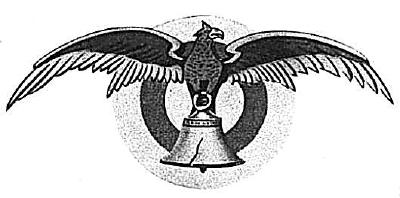 8th Aero Squadron insignia 8th Aero Squadron insignia
Approved February 14, 1924 (8401 A.C.)
World War IIReceive A-20As and A-24s (Jan 1941) On October 6, 1940 orders were received to move the Squadron to Savannah, Georgia. On January 10, 1941 the Squadron received its first shipment of Douglas A-20A Havoc attack bombers and six months later they received a small number of A-24 dive bombers.
According to the Joe Baugher on the A-24, "The first A-24 was delivered to the Army on June 17, 1941. The first operational A-24 unit was the new 27th Bombardment Group (L) based at Savannah, Georgia. Three of the four squadrons of the 27th BG were equipped with the A-24, plus one squadron of the 3rd Bombardment Group. The remaining squadrons of these groups were equipped with A-20A twin-engined level bombers."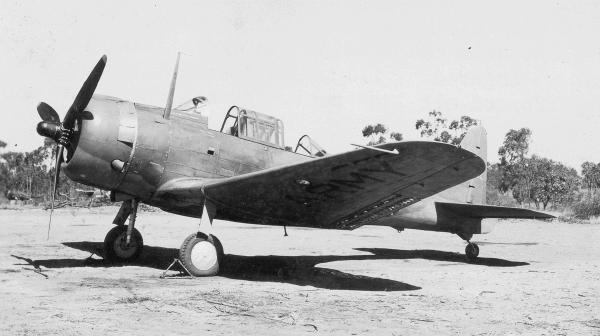 B. Roger's A-24 (Courtesy Bill Swain) B. Roger's A-24 (Courtesy Bill Swain) 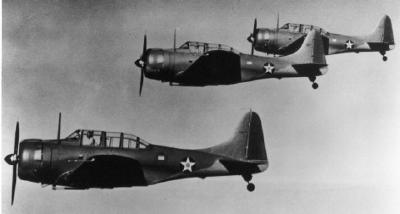 Douglas A-24D Dauntless/Banshee 3rd Bomb Group (Light) (WWII) Douglas A-24D Dauntless/Banshee 3rd Bomb Group (Light) (WWII)The Douglas A-24 Dauntless was a ground-attack aircraft equipped with massive wing-mounted dive brakes to assist it in performing its role as a dive-bomber. Over 5,300 were built before production ended. The A-24 was tentatively named Banshee by the Army, but this name never seems to have really caught on. The A-24 Banshee was the Army version of the Navy's SBD Dauntless dive-bomber. The USAF used 948 of the 5937 Dauntless' built. The A-24, A-24A and A-24B corresponded to the SBD-3, SBD-4, and SBD-5.
The A-24 was never very popular with its crews, and most of them were retained in the USA for training duties. After the 8th lost 5 aircraft on 29 Jul 1942, the A-24 was removed from combat. Following the New Guinea debacle, only one other squadron was to take the A-24 into combat. After the war, the Dauntless/Banshee was quickly phased out of military service. (Go to Joe Baugher's site at A-24 for more information.)  A-20 Havoc A-20 Havoc
According to Joe Baugher on the Joe Baugher: A-20A, " The initial order for 123 A-20A aircraft was later increased by 20, these being fitted with the more powerful Wright R-2600-11 engines, although these were still designated A-20A. They were added to the order in exchange for the A-17As that Douglas resold to Britain.
The first A-20A flew on September 16, 1940. The aircraft was delivered on November 30. The first deliveries to the USAAC took place in December. The A-20A went into service in the spring of 1941 with the 3rd Light Bombardment Group (formerly known as the 3rd Attack Group) at its new Savanna, Georgia base. USAAC units based Hawaii and the Canal Zone got 12 A-20As each, and the remainder were delivered to new Light Bombardment units, the 15th Bomb Squadron (Light) at Lawson Field, the 46th Bombardment Group (Light) at Bowman Field, and the 48th Bombardment Group (Light) at Will Rogers Field.
The Army liked the A-20A because of its excellent performance and because it had no adverse handling characteristics. Early aircraft were delivered in natural metal finish, with US insignia being carried only on the upper and lower wings."
The 8th would fly the A-20 Havocs off-and-on from 1941 through 1945. According to Joe Baugher on the Joe Baugher: A-20A, "The A-20A initially entered service with the USAAF in mid-1941, first being issued to the 3rd Bombardment Group (Light) based at Savannah, Georgia. A-20As were soon issued to the 27th Bombardment Group (Light). The engines of the A-20A were prone to overheating, and to alleviate this problem holes had to be cut around the periphery of the cowling just aft of the cylinder baffles. As soon as engine cooling problems had been corrected, the Army commented favorably on the qualities of the A-20A. The A-20A demonstrated its outstanding features during war games held at Shreveport, Louisiana during September of 1941. It had a performance comparable to that of many first-line fighter aircraft of the period."
8th Embarks for Australia (Jan 1942)In December 1941 the Japanese attacked Pearl Harbor and the 8th readied itself to enter the conflict. According to the 3rd Wing History, "A period of confusion ensued. Colonel Melville and other senior group officers departed to train other units as the Army Air Corps continued its rapid buildup. Lieutenant Robert F. Strickland assumed command on 19 January 1942, as the senior officer. Other lieutenants commanded the four fighter squadrons. The Army withdrew the group’s A-20s for use elsewhere, and ordered it to deploy with little equipment to Australia. The group departed Hunter Field by train for Oakland, California, between 19 and 23 January."
Acting on secret orders the Squadron moved to California. and shortly thereafter boarded the USAT "Ancon" on January 31, 1942 bound for Australia. They arrived in Brisbane, Queensland, Australia on February 25, 1942 as the first U.S. troops to reach Australia.
According to the 3rd Wing History, "Initially, it was assigned to United States Army Forces in Australia, then to the Allied Air Forces, Southwest Pacific Area, on 18 April 1942, and finally to the Fifth Air Force on 5 September 1942, where it remained for the duration of the war. The group, despite previous promises, found itself without aircraft. Calls to higher headquarters resulted only in promises. On 10 March, the 3rd Bombardment Group moved from its temporary camp in the Ascot Park racetrack outside Brisbane to Charters Towers on the north coast of Australia. Lieutenant Strickland commanded a force of 17 officers and 784 enlisted men who had no aircraft and very few ground vehicles. Squadrons assigned included the 8th, 13th, 89th and 90th Bombardment Squadrons. All served with the group throughout the war."
According toHistory, 8th Bombardment Squadron (L), 3d Bombardment Group (L) AAF, 31 May 1917 - 31 March 1944 (Compiled September 1945), "Upon arrival in Australia, the squadron had 14 officers and 149 enlisted men. Of this personnel approximately 85% were thoroughly trained."
According to the Galveston Tribune (dated April 26, 1957), "they moved from base to base, its members serving as ground crews for the 19th Bombardment Group's B-17's. Since the Third had no aircraft available and since additional training was necessary, it did not begin operations immediately." It went on to state, "On 6 March, the Squadron moved to Charters Towers, where a camp was hurriedly built while the air crews trained with their A-24 dive bombers. On 31 March, the air echelon flew to Port Moresby and the 8th was again at war."
The Philippines Falls One must remember that in the early months of 1942, the outlook for the U.S. forces in the Pacific was very bleak. The allies were being pushed back by the Japanese on all fronts -- and the Philippines was about to fall. A report of February 27, 1942 read, "SOUTHWEST PACIFIC AREA (SWPA, 5th Air Force): The Battle of Java Sea. Allied air and naval units try to stop a convoy of some 80 ships approaching Java from the NE. All available B-17's, A-24's, P-40's and LB-30's are put into the air but achieve only insignificant results. An Allied naval force, 5 cruisers and 11 destroyers, under Rear Admiral Karel W Doorman, Royal Netherlands Navy, meets the enemy near Surabaya, Java and is decisively defeated, losing 5 ships.
Most of the 5th Air Force ground echelon in Java is evacuated by sea. The SS Sea Witch delivers 27 crated P-40's to Tjilatjap, Java, but these will be destroyed to prevent their falling into Japanese hands. 32 P-40's aboard the Seaplane Tender USS Langley (AV-3), which sailed from Australia for India on 23 Feb, are lost when the USS Langley is sunk by aircraft 100 mi (160 km) S of Tjilatjsp. The pilots are rescued by other vessels in the convoy, but the enemy sinks these ships with the exception of a destroyer, which delivers 2 of the pilots to Perth, Australia. 13th Reconnaissance Squadron (Heavy), 43d Bombardment Group (Heavy), arrives at Melbourne, Australia from the US with B-17's; first mission is Oct 42." Things were not looking good. According to Kensmen: 5th AAF: April:
Tuesday, 7 April, 1942
During the night of 6/7 April, the Japanese break the Philippine II Corps front on Bataan, thus necessitating immediate removal or an remaining fighters to Mindanao, where for the next 3 days they will fly reconnaissance, cover heavy bombers (sent to Mindanao from Australia) operating against concentrations at Legaspi, Cebu, Iloilo, and Davao, and carry out a strafing attack aircraft at Davao. After the heavy bombers return to Australia on 12 Apr, the fighters will continue to fly reconnaissance until Japanese forces envelop the troops on Mindanao on 1 May. HQ 22d Bombardment Group (Medium) and 2d Bombardment Squadron (Medium) transfer from Ipswich to Townsville, Australia with B-26's; first mission is 8 April. 8th Photographic Squadron, Fifth Air Force (attached to Allied Air Forces) arrives at Melbourne, Australia from the US with F-4's; 2 flights remain at March Field, Riverside, California until 16 June. 18th Reconnaissance Squadron (Medium), 22d Bombardment Group (Medium), transfers from Brisbane to Townsville, Australia with B-26's; first mission is 21 April. 33d Bombardment Squadron (Medium), 22d Bombardment Group (Medium), transfers from Ipswich to Antil Plains, Australia with B-26's; first mission was 6 April.
Wednesday, 8 April, 1942
The air echelons of the 3d, 17th and 20th Pursuit Squadrons (Interceptor), 24th Pursuit Group (Interceptor), and 21st and 34th Pursuit Squadrons (Interceptor), 35th Pursuit Group (Interceptor) [attached to 24th Pursuit Group (Interceptor)] based on Bataan, Luzon, Philippine Islands begin operating from Mindanao Island, Philippine Islands with whatever aircraft are left.
Thursday, 9 April, 1942
Japanese capture Bataan, Luzon, Philippine Islands after 3 months. The US-Philippine forces surrender unconditionally. Japanese artillery emplaced on Bataan opens fire on Corregidor Island in conjunction with air attacks. 2nd Bombardment Squadron (Medium), 22d Bombardment Group (Medium), transfers from Townsville to Reid River, Australia with B-26's; first mission was yesterday. 7th Pursuit Squadron (Interceptor), 49th Pursuit Group (Interceptor), transfers from Bankstown to Batchelor Field, Australia with P-40's; they have been in combat since 14 March. After the fall of the Philippines, remnants of the 27th Bomb Group joined the 3rd Bomb Group. A number of important officers and enlisted men of the 27th Bomb Group were whisked out of the Philippines in 5 submarines just before it was overrun by the Japanese. On the night of the 3 May 1942, the last submarine, the "Spearfish" captained by James Dempsey, snuck into Manila Bay and picked up 27 passengers from Corregidor to be evacuated to Fremantle. Left behind on Corregidor were 173 officers, 2317 sailors and 4 nurses who all became prisoners of war. "Spearfish" was the last American submarine to visit the area before it surrendered.
According to the 3rd Wing History, "Shortly after the 3rd Bombardment Group arrived at Charters Towers, 42 officers and 62 enlisted men arrived with their battle worn Douglas A-24A Dauntless dive-bombers. They were the remnants of the 27th Bombardment Group that had survived the Japanese attacks on the Philippines and Dutch East Indies. One of the veterans, Lt Col John Davies, who had served with the 3rd Attack Group during the 1930s, formally assumed command of the 3rd Bombardment Group on 2 April as the senior officer. He immediately replaced the squadron commanders with more experienced men from his old group. He also assigned the A-24s to the 8th Bombardment Squadron. The other three squadrons remained without aircraft."
According to Charter Towers: Jack Heyn:During the month of March we received 42 officers and 64 enlisted men from the 27th Bomb. Gp. that were evacuated from the Philippines. Among them were Col. John Davies and Capt. P.I. (Pappy) Gunn. Davies became our Gp. Commander and Gunn our Gp.Materiel officer. We also received 24 A-24 Douglas Dauntless Dive Bombers, that the 27th pilots had picked up in Brisbane and headed back to the Philippines with. Due to the deteriorating situation in P.I. Java was as far as they got. So they were pulled back and assigned to our 8th Sq. According to Joe Baugher on the A-24, "The 27th BG was in the process of been shipped to the Philippines when the war broke out. The airmen were in the Philippines, but their aircraft were on their way via ship from Honolulu. The shipment was diverted to Australia, where they arrived on December 22. Some of the 27th BG pilots were evacuated from the Philippines to join their aircraft in Australia. Eleven A-24s flew up to Java in February of 1942, but this battle was already lost. The remainder began operations from Port Moresby with the 8th Bombardment Squadron on April 1, 1942. These units suffered heavy losses in the face of the Japanese advance. After five of seven A-24s were lost on their last mission (July 29), the A-24s were withdrawn from action as being too slow, too short-ranged, and too poorly armed. However, in all fairness to the A-24, their pilots had not been trained in dive-bombing operations and they often had to operate without adequate fighter escort."
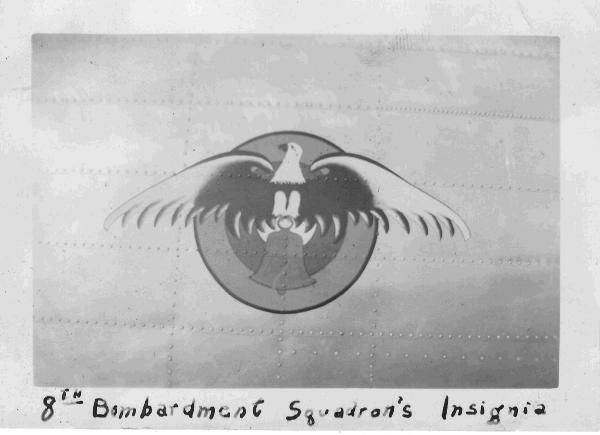 Charter Towers: 8th Bomb Squadron Emblem (Courtesy Bill Swain) Charter Towers: 8th Bomb Squadron Emblem (Courtesy Bill Swain)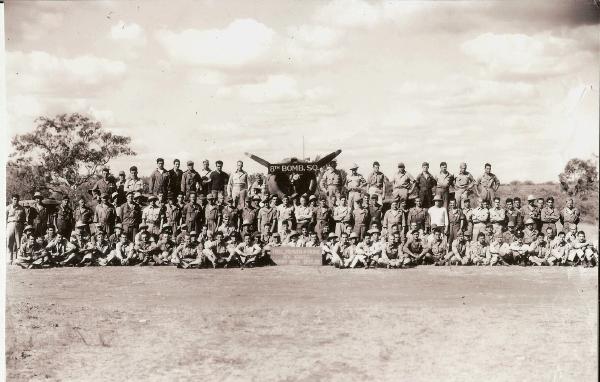 Charter Towers: 8th Bomb Squadron (Courtesy Bill Swain) Charter Towers: 8th Bomb Squadron (Courtesy Bill Swain)Kudos to Maintenance Personnel The history of the 8th is not only about the airplanes and events -- it is about the people, not only the leaders and flyers, but also the man with the crescent wrench and typewriter. It is easy to go to the histories and find the stories of glory and fearless acts of bravery. But what about the men on the ground who loaded that bomb that sank the ship. What about the armorer who loaded the ammo on the B-25 strafer that allowed the aircraft to fire and keep the heads of the enemy down so they could get their bomb on target. What about the engine troops who used two parts spit, glue and bailing wire with ten parts of ingenuity to keep the engines running without the proper spare parts. What about the crew chiefs who went without sleep to get their planes ready for its next mission. What about those communications folks whose radios were the only contact with the world when the aircraft headed on its mission. Instruments, electricians, and all the rest whose sole focus was getting those aircraft in the air. Without all of these tireless workers, there wouldn't be a history of the 8th. Every military leader knows that these unsung heroes are owed a debt of gratitude. When the pilots climbed into their aircraft, they were betting their lives on the work that these folks did.
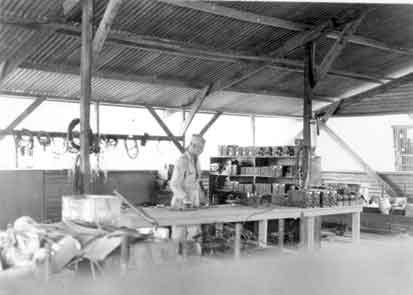 27th Air Depot Group, 7 mile 27th Air Depot Group, 7 mile
Radio Shop (Aerothentic)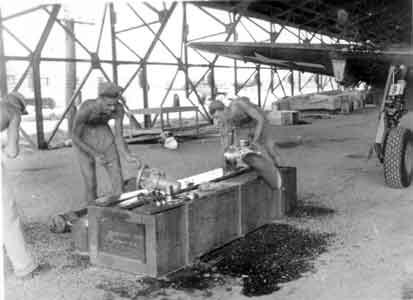 27th Air Depot Group, Port Moresby 27th Air Depot Group, Port Moresby
Prop Shop (Aerothentic)Jack Heyn a photographer with the 13th Attack Squadron wrote, ""Before the war the Army Air Corps used the "pitch" to get new recruits by proclaiming that it took ten men on the ground to keep one man in the air - join the Air Corps for a career in Airplane Mechanics, Radio Communications, Armaments, Photography, etc. I don't know how accurate that assumption was but I expect it was pretty close. Of that group, the most important, and most unsung, were the aircraft mechanics that kept those magnificent flying machines flying. They took great pride in their work, their airplane and their combat crews. Some of our crew chiefs on B-25s flew on missions with their planes. In fact a few of them flew the plane going to and coming from - as long as there was no danger of enemy action. I don't know how prevalent that practice was in other units, but I know it was done in the 13th Squadron the year I was with them.
You know, there were an awful lot of unsung guys on the ground that made each unit and the 5th Air Force what it was - one of the most active and effective Air Forces in the war - the Radio Shack guys, the Armorers; it was no picnic handling all those bombs and ammunition day in and day out, the Motor Pool that kept things and crews moving, the medics who kept the guys healthy, and were 'Johnny on the Spot' when those planes came home with wounded men on board, the clerks who kept the paper work going, and saw to it that there was money on hand every month for those ever-present poker games, the cooks that kept the guys fed as well as could be expected under the circumstances.
Consider even the Photo Section, a few flew combat, but mostly we kept the cameras in working order, picked up the film when the planes came in, processed it and got it over to 5th Bomber Command, usually in the wee small hours of the morning. All the Groups, regardless of type - fighter, bomber, Transport or Service unit - were made up of a combination of these men" 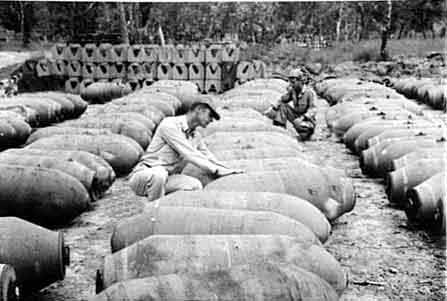 Wards Drome, Port Moresby Wards Drome, Port Moresby
1000 lb bombs in Bomb Yard (Aerothentic)Move to Charters Towers (March 1942) A camp was set up in on 17 March 1942. A few days later the Squadron moved to Charters Towers, Queensland, Australia. In March 1942 - 42 officers, 62 enlisted men and 24 A-24's were assigned to the 3rd Bomb Group stationed at Charters Towers. They were assigned to the 8th Squadron. According to Charter Towers: Jack Heyn: March 10, '42 we arrived Charters Towers, Q'land. An old gold mining town about 90 miles inland from Townsville in N.E. Queensland. They were in the process of building and air strip and that was to be our home for the next 10 months. On Mar. 12, I celebrated my 19th birthday, and believe me there was no party. I went to bed that nite bushed. The next couple weeks we were busy unloading our equipment; setting up tents to live in, eat in and work in; and digging slit trenches to jump in, in case of an air raid. I use the word dig loosely. I don't know what kind of soil it was, but one did not dig it - one picked in out with a pick axe. It took the best part of two weeks to get them all dug. Having been shipped over sans aircraft and senior officers, we were in no shape to fight a war. Supposedly aircraft were supposed to have been sent for us, but nothing ever materialized. 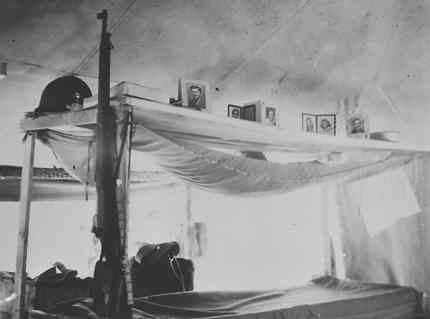 Bunk at Charter Towers (Jack Heyn) Bunk at Charter Towers (Jack Heyn)
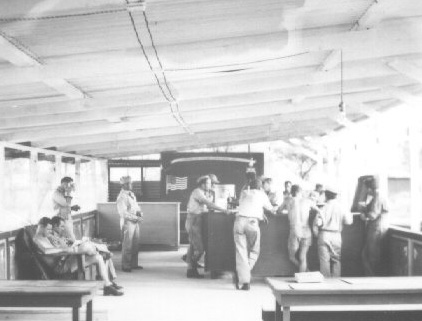 Enlisted Club at Charter Towers (Jack Heyn) Enlisted Club at Charter Towers (Jack Heyn)
According to Peter Dunn's Australia @ War web site www.ozatwar.com: The 3rd Light Bombardment Group comprising A-24 Dauntless Dive Bombers, A-20 Havoc Bombers and B-25 Mitchell bombers moved to Charters Towers on 1 March 1942. The first aircraft to land at the newly constructed airfield was Major "Big Jim" Davies of the 8th Squadron in his A-24.
On 1 April 1942 the 3rd Bomb Group pulled their first combat mission of WW II. Six a-24's, led by Lt. Bob Ruegg (retired as Lt Gen. of the Alaskan Command) were headed for Lae Airdrome. Lae was socked in by weather so they diverted to Salamaua. They dropped 5 bombs, a very inauspicious start for a Group that was to become one of the most active units in the Army Air Forces in WW II.
On 5 April 1942, the B-25's that "Pappy" Gunn and "Big Jim" Davies had appropriated from the Dutch, were used in their first combat in an attack on Gasmata. (SITE NOTE: The 8th attacked an airdrome at Lae and the 13th bombed installations at Gasmata, flying the B-25 for the first time against the Japanese.)
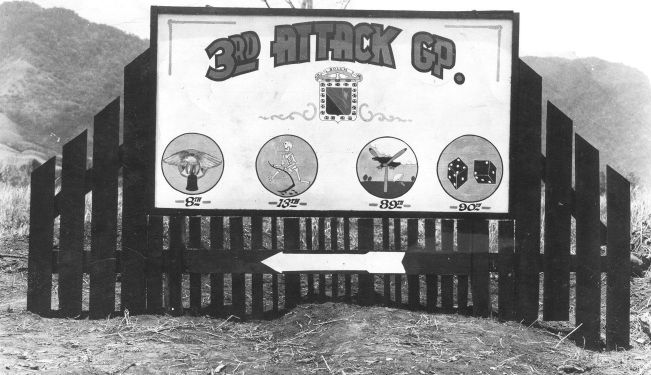
3rd Attack Group Sign
Note Squadrons of Group: 8th, 13th, 89th and 90th Squadrons (Bill Swain)
The following is from History, 8th Bombardment Squadron (L), 3d Bombardment Group (L) AAF, 31 May 1917 - 31 March 1944 (Compiled September 1945), taken from the 8th Bombardment Squadron Unit History for May
1945. Written by capt. David J. Donovan, Squadron Adjutant. Our First Overseas Station In June 1942, our squadron was stationed at Charters Towers, Queensland, Australia. At this time the organization operated A-24 aircraft, the old Douglas Dauntless dive bombers. Combat missions
were conducted by staging from Kila Kila Airdrome, Port Moresby, New Guinea. Planes would be flown by pilots, accompanied by gunners, from Charters Towers to Moresby. An air echelon consisting of personnel
from engineering, armament, communication, mess and operations sections would travel by boat from Townsville to Port Moresby. Members of the air echelon would remain in New Guinea from two weeks to
three months at a time. All other men in the squadron stayed at Charters Towers.
The camp was situated outside the town of Charters Towers, a town of 3,000 to' 4,000 people. It was amidst a countryside of dull reddish brown earth. In the distance were dreary mountains covered with coarse vegetation and scattered forest.
When the squadron commenced setting up camp in March of 1942, the picture was anything but cheerful. The swift and startling successes of the Japanese had carried them in the East Indies and New Guinea close to the very shoreline of Australia. It even appeared that the Allies would have to abandon all territory north of Brisbane which is 650 miles south of Charters Towers.
Under these conditions the squadron had to be prepared to move on extremely short notice. No permanent buildings could be constructed. Each man's residence was a tent with sand floor. Mess halls and administrative structures were also bare floor tents.
The camp was built on almost completely flat ground. Along the edge of the camp ran a small creek. Sometimes torrential rainfall would cause the stream to overflow into the squadron area. The operations line was located about two miles from camp. All administrative work of the technical sections of the squadron was conducted from the line area. Working.hours were' from 0700 to 1600.
The officers and enlisted men had clubs. At first a tent with sand floor and a few tables comprised each club. During the last two months at Charters Towers two improvements were made. A bar was installed
and floors were cemented. Both clubs were stocked with ample beer, liquor, soft drinks and other refreshments common to the States. The Aussie beer was a big seller. When the beer ran out the men really would moan. That meant another trip to Townsville for more beer.
Motion pictures were the only other entertainments. in camp. However, when the men became fed up with camp life they could go to town during non-duty hours and at night. Transportation left camp for town at
regular intervals. The last truck headed for camp departed from the town at 0100. Unfortunate individuals who missed it, were compelled to hitch-hike or walk back to the squadron area.. That wasn't too bad. The only requirement was that the men had to return before work call at 0630.
Charters Towers is an old mining town which had seen far better days. Its buildings are reminiscent of those of a Western settlement of the 1890's. A peculiar feature of Charters Towers is its numerous goats which amble unconcernedly along its main street.
There were many restaurants and beer gardens to provide for the men. Fair to middling steaks, malted milks and sandwiches could be purchased at these establishments. An American Rod Cross provided delicious hamburgers and coca-cola.
Combat missions were flown from April 1st to July 29th, 1942. The 8th Squadron flew the first. bombing mission.of the war in New Guinea. On July 29th, terrible tragedy struck the organization. Five of seven
planes that had taken off on a mission against a Japanese convoy off Gona, New Guinea were shot down by enemy fighter planes. Thereafter the air echelon was sent back to Charters Towers and the A-24s condemned for combat.
After combat operations had ceased and in absence of work, much grumbling and discontent arose. The men had more time to talk about returning to the States. Some thought that six to nine months at so
"horrible" a place as Charters Towers was too much for any human being. As for New Guinea, no white man could withstand its terrible humid torrid climate for more than four continuous months. What sadly deluded
men. They never knew what was in store for them.
Other members of the squadron actually expressed a desire to move to New Guinea. They believed a change from dull dreary Charters Towers would be beneficial. Their wishes were soon fulfilled. On January 23rd, 1943, the organization cleared Camp, located and boarded a Liberty boat at Townsville and set sail for Port Moresby.
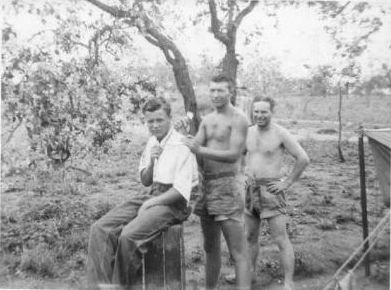 Charter Towers Barbershop (Courtesy Bill Swain) Charter Towers Barbershop (Courtesy Bill Swain)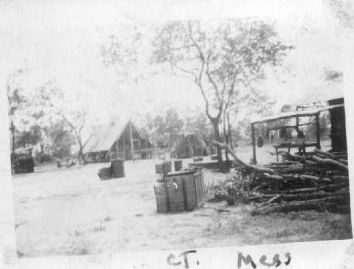 Charter Towers Mess (Courtesy Bill Swain) Charter Towers Mess (Courtesy Bill Swain)8th Starts Flying B-25s (Mar 1942): These B-25s were Dutch aircraft at Archerfield that had been ordered by the Netherlands East Indies before the war. There were 12 of them that were sitting idle as the Netherlands had surrendered to the Japanese. These were immediately "requisitioned" by the USAAF in the desperate attempt to halt the Japanese advance toward Port Moresby. It was agreed that the Dutch government would be credited accordingly, or else the planes would be replaced on a one-to-one basis by later deliveries.
According to Charter Towers: Jack Heyn: In the last week of March we received about 24 B-25's. Unfortunately 3 of them cracked up on landing. Our pilots were all either A-20 or A-24 pilots, and hadn't been checked out on B-25's. These planes had belonged to the Dutch Air Force, but had been sitting in Brisbane, because the Dutch didn't have any pilots to fly them. One story goes that we literally stole them from the Dutch (supposedly they had broken locks on the hatches) another story goes that the Dutch transferred them over to the U.S. since we had the personnel to fly them. To this day I don't know which is the truth. According to Lawrence Cortesi in the History of the 3rd Bomb Group, 1918-1965, there was a slightly different account:"THE GRIM REAPERS"
History of the 3rd Bomb Group, 1918-1965
by Lawrence Cortesi
Published by Historical Aviation Album.
On 27 March, a few days after Davis took over the Reapers, Gunn came into Big Jim's (Lt. Col. John Davis) office and grinned. "Johnny, there's a couple dozen B-25s at Batchelor Field in Melbourne." (Note - I know of a Batchelor AIr Field in the Northern Territory. Is anyone aware of a Batchelor field in Melbourne?)
Davis was surprised and asked if the executive officer had heard anything. Strickland (1st Lt. Bob Strickland) shook his head. He had not heard of any aircraft reaching Australia for consignment to the 3rd Bomb Group. Davis then turned to Gunn with a frown.
"They aren't exactly ours," Gunn said. "I think they've been allocated to the Dutch Air Force, but from what I hear, they'll never use them because they have no pilots. The planes are just sitting there, and we've got a war to fight. Why don't we go down and get them."
Davies grinned. "You mean steal them?"
"They said our planes were on the way," Gunn shrugged. "Who's to say those Mitchells aren't ours?" He leaned close to Davies. "Go see Eubank; he's a friend of yours. Tell him your planes are at Batchelor Field and you'd like an authorization to pick them up.
"You're crazy, Pappy," Davies said. "All I know-those Aussies could sure use aerial help up in New Guinea. We could give them plenty with 24 Mitchells." Davies flew immediately to FEAF ADVON headquarters in Brisbane to see General Eugene Eubank who had been a Philippines acquaintance of Davies when Eubank commanded V Bomber Command, Eubank welcomed Davies' visit until he learned the colonel's mission.
"If you give me an authorization," Davies said, "I'll take a load of pilots down there to pick up the planes. Gunn says he can have them ready for combat right away."
"If I'm not mistaken," Eubank said, "those Mitchells are consigned to the Dutch."
"They said our planes were on the way," Davies said. "It wouldn't be your fault if we picked up the wrong planes; if we mistook those B-25's for the planes Washington promised us."
Eubank pursed his lips. "I don't know; that wouldn't be by the book."
"When did we start going by the book?" Davies asked, as he leaned closer to the general. "We could do an awful lot of damage up in New Guinea with those ships."
Eubank grinned again. "What've we got to lose except our necks, and we won't have those anyway if those Nips keep coming on the way they are."
After the 3rd Group commander got the authorization, he flew quickly back to Charters Towers. He rounded up 24 pilots, including himself, Pappy Gunn, and Bob Strickland. When the mail plane landed, Big Jim and his airmen were waiting on the field.
After service crews unloaded the cargo, and while tank men refueled the aircraft, Davies and his men climbed aboard. When the pilot and co-pilot returned to the plane, they were surprised to see 24 pilots crammed inside.
"Colonel," the pilot asked Davies, "What's going on?"
"We're going to Melbourne to pick up our B-25's," Big Jim said. He showed the pilot the authorization from General Eubank.
"Okay," the transport pilot shrugged. "We'll be making a stop at Archer Field (Archerfield) in Brisbane to refuel. We should reach Melbourne about 1700 hours this afternoon."
The C-47 then took off for the 900 mile trip to Batchelor Field, stopping briefly at Brisbane. By 1700 hours, the Gooney Bird was landing. Most of the Reapers had slept during the trip so they were well refreshed to fly the "hot" bombers back.
With a nonchalant air of authority, Davies presented his authorization to an American OD Officer at the field. The duty captain, like others around the base, knew little of high level decisions concerning allotments, strategies, or operations. "I wondered who the hell owned these planes," the officer said. "They've been sitting here a couple of weeks."
The captain did not question the authorization. In fact, he called an ordnance NCO to check the fuel supply and to warm up the planes. After a hot meal, the 3rd Group pilots boarded the B-25's. At 1830 hours, as the sun began setting below the Melbourne River, they took off. By 1900 hours, the last B-25 was droning northward.
Not until 2100 hours did somebody at Batchelor Field discover that an air corps Lt. Colonel had taken off with 24 unauthorized B-25's. The OD officer had talked about the incident in casual conversation during an evening bull session and he was overheard by two staff officers who knew the bombers had been consigned to the Dutch. Within a half hour, the shocked twosome were frantically making phone calls up and down the east coast of Australia to determine how Davies had shammed an authorization to pickup the planes.
Meanwhile, Davies stopped at Brisbane's Archer Field (Archerfield) to refuel. But, before the 3rd Group pilots could take off, the base commander and a squad of MP's met them with fire in their eyes.
"Colonel, Sir," the major said, "I have orders from FEAF to hold these planes here in Brisbane and to detain you and your men. Your authorization is invalid and nobody can reach General Eubank to verify your orders."
"Major," Davies said, "I have a written authorization and you know that under AR regulations a signed order supercedes an oral one."
"Are you questioning General Eubank, Major?" Pappy Gunn suddenly blurted.
The base commander rolled his tongue around his lips.
"We need those planes, Major," Davies said soberly.
The base commander looked at the pilots in their cockpits wearing a mixture of apprehension and supplication on their faces. Davies' argument about the written authorization was a weak one, for the major had authority from FEAF VIP'S. He squinted at the B-25's, their fuselages shaking from warming engines--like anxious greyhounds ready to pursue game.
"As soon as we get these planes to Charters," Pappy said, "we'll have them hitting Lae and Salamaua within a couple of days."
The major looked at the middle aged Mad Professor. "Are you Captain Gunn?"
"Yes.
The major grinned. He knew Pappy's reputation,
"Yes", he said, "I suppose you will have those planes ready in a couple of days."
"I guarantee it," Gunn said.
The major looked at Davies and sighed. "Okay, Colonel, I guess a written order does supercede an oral one," as he cocked his head and the MP's moved off.
Soon, the major stood on the field and watched the Mitchells soar into the sky. He ignored a clerk who had rushed out to the field to tell him that FEAF wanted to know if the bombers had been held as requested. Not until the last B-25 had disappeared to the north, did the base commander return to his office to call an aide of General Brett himself.
"I'm sorry, Sir," the major told the FEAF officer, "we're too late. The planes have already taken off."
"What? You let them go off with those bombers?"
"Colonel Davies had a written authorization and he left before I could determine whether of not the authorization was valid."
"You idiot," the aide cried, "I'll have your ass. "
"Yes Sir."
At 2400 hours, while a deep midnight darkness hung over Charters Towers, the drone of planes prompted the men of the 3rd Group to rush onto the air strip and ignite lights. Swiftly, the B-25's touched down on the runway and taxied to the far end of the strip, while waiting vehicles led them to the revetment areas. By 0100 hours, the pirated bombers had been safely tucked away and the lights snuffed out.
Grim Reaper ground crews hugged the clean olive green surfaces of the Mitchells, almost awed by the sight and smell of the new planes. Unlike the A-24's that Davies had brought originally, these bombers did not need service, new engines, new electrical equipment, armament systems, or extensive overhauls.
In Brisbane, meanwhile, the understanding major was already confined to quarters for possible court martial because he had allowed an air corps officer to abscond with 24 new aircraft without proper authorization.
The Dutch reacted furiously, demanding that FEAF return the planes at once. However, when a FEAF officer asked if they had pilots to fly the Mitchells back to Melbourne, the NEI officer was strangely mum for a moment. He then muttered, "The Americans took them and they should fly them back."
FEAF headquarters, meanwhile, sent a frantic message to Charters Towers: "Return 24 B-25's to Batchelor Field at once." But, 3rd Group clerks said they needed to check with Colonel Davies who, unfortunately, was unavailable at the moment. FEAF probers got similar blanks from ADVON FEAF in Brisbane.
"Sorry, General Eubank is somewhere in the field." Thus, the Melbourne brass could only tell the Dutch that Air Force headquarters in Australia would form a board of inquiry to look into the matter.
Not until 24 hours later did somebody at FEAF finally reach General Eubank. Eubank pleaded ignorance. He had merely allowed Davies to pick up the allotted B-25's that had apparently arrived in Australia as promised by Washington. Eubank was not to blame if the report had been false and Davies had picked up the wrong aircraft.
The aide grumbled but a moment later, General Brett was on the phone. "Gene, we could have an international incident over this thing. The Dutch are furious and if they go to the state department, God only knows what'll happen. You'll need to get those planes back to Batchelor Field."
"I can't do that," Eubank said.
"What the hell do you mean, you can't?"
"Am I in charge of FEAF planning or not?" Eubank asked.
"Sure, but what's that got do with it."
"The Nips are building up Lae and Salamaua, and I plan to hit those bases with these B-25's. We've already made arrangements to stage them out of Moresby."
"Goddam it, Gene," Brett growled, "they'll have my ass."
"If we can hurt those Japs, it'll be worth it."
"Okay," Brett sighed. "I'll go along."
Yet, the brazenness of the 3rd Group airmen had not ended. On the same 30 March day, Captain Gunn and his engineering crews readied the B-25's for combat, but discovered that the planes did not have bomb sights. The instruments were still in Brisbane. John Davies was shattered, but Pappy promised to get them. He flew at once to Batchelor Field.
With unmitigated boldness, Gunn walked into the Dutch supply building at the base and demanded the bomb sights for the B-25's. The Dutch, already infuriated, wondered how the Americans now had the audacity to ask for anything. The request was refused. The story then prevailed in Melbourne that Pappy Gunn aimed a tommy gun at the depot personnel and ordered them to give up the bomb sights or else. Whether or not Pappy actually made such a threat with a gun is mere rumor, but one thing is certain: Gunn returned to Charters Towers with the bombsights for the B-25's.
SITE NOTE: According to Joe Baugher: B-25C in Dutch Service, the Dutch B-25s were delivered equipped with Norden bombsights, considered top secret at the time, since the Sperry alternates were not available and the B-25 had been produced to accommodate the Norden. The time and effort to refit the planes for the Sperry sight would have caused unacceptable delays in deliveries, and the US government somewhat reluctantly approved the inclusion of the Norden in the Dutch planes.
Three of these Dutch B-25's may have arrived at Archerfield on 9 March 1942, being part of the first delivery of aircraft. They may have flown via West Africa. According to Joe Baugher: B-25C in Dutch Service "It was agreed that the B-25s in Australia would be used as the nucleus of a new squadron, designated No. 18. This squadron would be staffed jointly by Australian and Dutch aircrews plus a smattering of aircrews from other nations, but would operate at least initially under Royal Australian Air Force command. However, the B-25s of No. 18 Squadron would be painted with the Dutch national insignia (at this time a rectangular Netherlands flag) and would carry NEIAF serials.
However, the Archerfield B-25s were immediately "requisitioned" by the USAAF in the desperate attempt to halt the Japanese advance toward Port Moresby. It was agreed that the Dutch government would be credited accordingly, or else the planes would be replaced on a one-to-one basis by later deliveries. The next batch of B-25Cs were promised to the Dutch, but these too were seized by the USAAF. The first five B-25Cs delivered to this squadron had carried the NEIAF serial numbers N5-132, N5-134, N55-135, N5-136 and N5-151. In late June, another five (N5-122, N5-124, N5-125, N5-126, and N5-127) were delivered, apparently replacing the first five B-25Cs which had "disappeared" into USAAF service during the interim."
In March 1942, Col. Davies assigned the North American B-25 Mitchell bombers to the 13th and 90th Bombardment Squadrons. The 89th Bomber Squadron provided maintenance and other support until August 1942, when it received A-20s. At this time, the 8th also flew the B-25s while awaiting its full complement of A-20s.
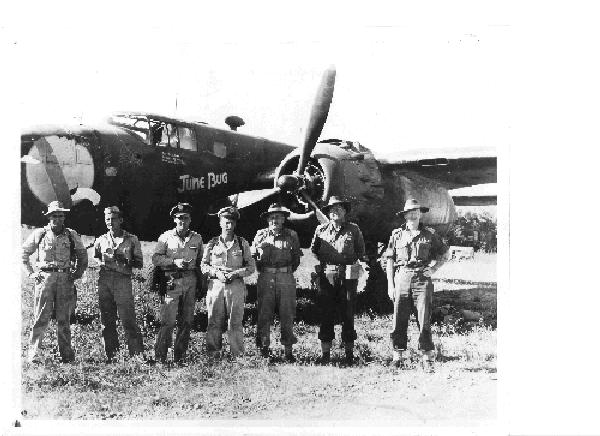 Charter Towers: 8th Squadron "We are the First" (Courtesy Bill Swain) Charter Towers: 8th Squadron "We are the First" (Courtesy Bill Swain)
North American B-25 Mitchell According to Joe Baugher: B-25,On March 11, 1939, the Air Corps issued Proposal No. 39-640 for the design of a medium bomber. According to the specification, a bombload of 3000 pounds was to be carried over a range of 2000 miles at a top speed of over 300 mph. The proposal called for either the Pratt & Whitney R-2800, the Wright R-2600, or the Wright R-3350. Requests for proposals were widely circulated throughout the industry. Proposals were received from Martin, Douglas, Stearman, and North American.
Lee Atwood, North American's vice president and chief engineer, took charge of the medium bomber project. North American's proposal was given the company designation of NA-62. It drew heavily on the NA-40B design, and retained the basic format of that earlier design. However, the NA-62 was a somewhat larger airplane with greater speed, range, and payload capacity. The wing area was some ten square feet larger than that of the NA-40, and the fuselage was six feet longer. Gross weight of the NA-62 was 28,000 pounds, as compared to 20,000 pounds for the NA-40B. In order to incorporate the increased bombload demanded by the new specification, the raised tandem cockpit of the NA-40B was replaced by a side-by-side cockpit with a top line that conformed with the top of the main fuselage. This made for a wider fuselage, and the bombardier's passage to the nose was by a crawl tunnel underneath the flight deck. The wing was lowered from the high shoulder position on the NA-40B to a mid-fuselage position, but it retained the continuous three-degree dihedral of the original design. An NACA 23017 airfoil was selected for the wing root, changing to a NACA 4409-R airfoil at the tip. A slight camber reversal or "reflex" was incorporated at the tip trailing edge which moderated stall characteristics. The nacelles of the Wright Cyclones were extended aft of the wing, and the mainwheels retracted backwards into the engine nacelles.
The crew was five--pilot, copilot, bombardier, navigator/radio operator, and gunner. The navigator's compartment was directly behind the flight deck.
The armament consisted of four 0.30-inch machine guns on flexible mounts. There was a 0.30-inch machine gun in the nose which could be installed on any one of three ball-and-socket mounts cut into the nose (one pointing straight ahead and one to each side). Another 0.30-inch flexible gun was mounted behind a Plexiglas hatch cut into the upper rear fuselage. A third 0.30-inch machine gun had firing positions at each waist window and from a hole in the floor. There was a 0.50-inch machine gun in the extreme tail, mounted in a streamlined transparent canopy. The tail gunner lay prone in this position, the Plexiglas canopy featuring clamshell doors which opened sideways to permit traversal of the gun. Maximum offensive load was 3600 pounds of bombs.
The NA-62 was submitted in time to meet the Army's September 10 deadline for the medium bomber competition. The Army was sufficiently impressed with the North American proposal that on August 10, 1939, they issued a contract for 184 NA-62s under the designation B-25. This contract was finally approved on September 10. At the same time, the competing Martin Model 179 was issued a contract for 201 examples under the designation B-26. Since the design had been ordered "off the drawing board", there was no XB-25 as such.
A full scale B-25 mockup was approved on November 9, 1939. Construction of the first B-25, serial number 40-2165, was in final assembly by the early summer of 1940. The first flight took place on August 19, 1940, test pilot Vance Breese being at the controls and engineer Roy Ferren sitting in the right hand seat.
Two of the early B-25s were delivered to Wright Field for tests, while the first B-25 was retained by North American. Eight more B-25s were built with the original continuous wing dihedral, but Wright Field tests showed that this feature led to some directional instability, including the phenomenon of "Dutch roll". In addition, the aircraft made banked rudder turns with such a configuration, which was unacceptable to the military, which required flat rudder turns when making making small heading corrections during the bomb run. This was cured by adopting a cranked or "gull" wing, with the sections outboard of the engine nacelles being changed to horizontal. This change cured the instability problem. Exactly when this change was introduced is a matter of uncertainty. It has been reported that this change was introduced on the tenth B-25 built, but there are no records to confirm this. This "gull" wing configuration was retained throughout the entire Mitchell production run.
The first few B-25s experimented with various geometries for the vertical fins. The original configuration resembled that of the defunct NA-40B. The fins were gradually enlarged and squared off, the second and third configurations being rather ungainly rectangular-shaped verticals. After additional testing, a flattened triangular shaped was attempted before the final, back-tilted fin and rudder configuration was adopted.
The idea of honoring General "Billy" Mitchell by naming the B-25 in his memory was apparently the idea of Lee Atwood. The Air Corps readily agreed.
The first B-25 was accepted by the Army in February of 1941. The first recipient of the B-25 was the 17th Bombardment Group based at McChord Field in the state of Washington, 19 examples ultimately being delivered. One B-25 each was sent to Chanute and Lowry Fields, with a couple being retained at the North American company. A total of 24 B-25s were built.
Following the completion of its test series, the first B-25 (40-2165) was modified by North American Aviation as a company transport. All military equipment was removed and seven seats were installed in the main fuselage. The bomb bay was converted for baggage and a bunk was installed in the crawl space above the bomb bay. Windows were cut into the sides of the fuselage and the greenhouse nose was completely faired over. It crash-landed on January 8, 1945 during a routine check flight. The crew was uninjured, but the aircraft was damaged beyond repair.
In 1943, B-25 40-2168 was modified as General Arnold's personal airplane. This plane was one of the nine constant-dihedral B-25s. It had its wing panels revised to zero degree dihedral. The modifications were otherwise identical to those carried out on 40-2165. The extent to which the General actually used this airplane are unknown. After the war it was sold as surplus on the commercial market, passing through several owners (including Howard Hughes). The plane remains in airworthy condition as N2825B.
Serials of B-25 Mitchell
40-2165/2188 North American B-25 Mitchell
company numbers 62-2834/62-2857
Specification of North American B-25 Mitchell:
Engines: Two Wright R-2600-9 Double Cyclone fourteen-cylinder air-cooled radials, each rated at 1700 hp for takeoff and 1500 hp at 2400 rpm. Performance: Maximum speed 322 mph at 15,000 feet. Service ceiling 30,000 feet, range 2000 miles with 3000 pounds of bombs. Weights: 17,258 pounds empty, 28,557 pounds maximum. Dimensions: Wingspan 67 feet 6.7 inches, length 54 feet 1 inches, height 16 feet 4 inches, wing area 610 square feet. Fuel: two forward wing tanks, total 484 gallons. Two rear wing tanks total 432 gallons. One droppable bomb bay tank, 420 gallons. Armament: one 0.30-inch machine gun in flexible mount in the nose. One 0.30-inch machine gun in a flexible dorsal position. One 0.30-inch machine gun in flexible waist position. One 0.50-inch machine gun in flexible tail position.
 B-25 Strafer B-25 Strafer
The modifications to the B-25s that Pappy Gunn had appropriated from the Dutch earned these aircraft the nickname of the "Townsville Strafers." According to Joe Baugher: B-25C/D Strafers,One of the more successful field modifications performed on the B-25Cs and Ds were conversions to heavily-armed strafers.
The basic concept for the strafer seems to have originated with B-25 units based in Australia. Medium-altitude bombing attacks against Japanese shipping had not been all that successful, since most of the bombs tended to miss their targets. This was due partly to the fact that medium and high-altitude bombing was subject to inherent errors in accuracy due to uncertain winds and to difficulties in sighting, but also due to the fact that ships could often see the bombs coming their way and had enough time to get out of their path. General Kenney felt that the development of skip-bombing techniques would give a much better chance of success. In skip bombing, the pilot approaches the target ship at a speed of 200 mph and at an altitude no higher than 250 feet off the water. Releasing the bomb at that height or lower caused it to skip off the water and slam into the ship just above the waterline, giving a much better chance of a hit than conventional bombing from medium altitudes. However, this technique required a low-level straight-on approach against intense anti-aircraft fire from heavily-armed ships. It was felt that heavy forward-aimed firepower aboard the attacking aircraft was needed to counter this defensive fire.
This technique had already been tried out to a limited extent with the A-20 Havoc, but the A-20 had a relatively low bombload and a limited range. In addition, there was a severe shortage of A-20s in Australia and in the entire South Pacific due to the priority of Lend-Lease deliveries to the Soviet Union. The idea of modifying the B-25 as a "strafer" seems to have originated with NAA field service representative Jack Fox and Major Paul I. "Pappy" Gunn of the 3rd Bombardment Group. Fox and Gunn satisfied General Kenney that this was an idea worth trying, and the General gave them authorization to proceed.
B-25C serial number 41-12437 was chosen for the initial tests. Since in a low-level, high-speed attack the bombs would be released by the pilot, there was no need for a bombardier. Consequently, the bombardier position was removed and replaced with a package of four fixed 0.50-inch machine guns with 500 rpg and aimed directly forward. The guns protruded from a metal plate that replaced the flat bomb-aiming panel. In addition, four more fixed 0.50-inch machine guns were installed in individual external blisters, two on each side of the fuselage. Blast protection from the fuselage blister guns was achieved by using blast tubes on the gun barrels and by mounting large sheet metal plates on the fuselage sides that covered the entire blast area. The plane was appropriately named "Pappy's Folly". In the first tests, the fuselage guns were found to be too far forward for the center of gravity, and were later moved further aft.
Trials were sufficiently impressive for General Kenney to order more strafer conversions. By the end of February 1943, twelve strafers were completed by the Eagle Farms operation in Australia and assigned to the 90th Squadron.
The strafer concept proved particularly effective during the Battle of the Bismarck Sea of early March 1943. USAAF A-20s, B-17s, B-25s along with Australian Beauforts and Beaufighters took part in coordinated and repeated attacks on a Japanese convoy headed from Rabaul to reinforce their forces based at Lae, with P-38s and P-40s flying top cover. The strafer B-25s proved especially effective during this episode, attacking the convoy from nearly masthead altitude using skip-bombing techniques to attack the ships broadside, the withering fire from the eight forward-firing 0.50-inch machine guns preventing any effective return fire. Out of the original convoy of eight destroyers and eight cargo vessels that had departed Rabaul, all the transports and four of the destroyers were sunk or beached. The B-25C/D strafers achieved a 43 percent hit ratio.
Against land targets, these B-25s were rigged with bomb bay cages that contained up to 100 23-pound parachute fragmentation bombs. These bombs were released in great numbers to attack airfield dispersals and flak batteries.
The strafer concept was so successful that by September 1943, 175 B-25Cs and Ds had been converted for low-level strafing by the depot at Townsville, Australia. By that time, five squadrons had been so equipped.
Other commands soon picked up the concept. The 241st Bombardment Group based in the CBI Theatre modified a number of B-25C/D aircraft as strafers with various different nose gun arrangements. They were used with success against railways, marshaling years, highway transport and storage depots. the 41st Bombardment Group of the 7th Air Force in the central Pacific used strafers that were quite similar to those from Townsville.
The concept even reached the Mediterranean theatre of operations, where 16 B-25s were modified by the 26th Air Depot Group in Egypt with a six-gun nose. However, these planes were later returned to standard transparent-nose configuration, which indicates that the "strafer" concept was not all that widely used in the Mediterranean and European theatres.
Following the development of the B-25C/D strafers mounting eight forward-firing guns, Major Paul Gunn developed an experimental installation of three additional guns to the underside of the fuselage between the bomb bay and the forward access hatch. This idea proved to be impractical due to feed belt problems and blast effects to the adjacent structure.
The North American factory came up with the idea of installing a fuselage-mounted module containing two 0.50-inch machine with 225 rpg. The unit fit into the forward access hatch. This installation had the advantage in that servicing of guns and replenishment of ammunition could be done from inside the aircraft, but it had the disadvantage in forcing the crew to enter the aircraft from the aft hatch, then crawl over the bomb bay to get to the forward cockpit. The unit was never ordered into production.
The success of the "strafer" modifications to the B-25C/D led to the B-25G, which was a dedicated factory-built strafer that was succeeded by the more efficient B-25H. However, it was not until the advent of the solid-nosed B-25J that the power of the famous "Townsville" strafers was equalled. 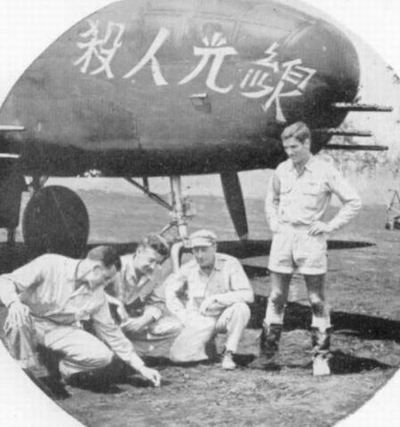 Sting of Death (Courtesy Bill Swain) Sting of Death (Courtesy Bill Swain)
Bill Swain wrote, "Here's a pic of one of the original Strafers "Sting of Death" modified by Pappy Gunn.. The guy standing to the right and wearing the Aussie flying boots is BG Ret. Bill Webster, one of the 8th's pilots who flew the Nov 2 Mission to Rabaul." Later William Webster added, "The other three 8th Sqdners are left to right all Captains: George Schwartz (Pilot), Marty Radnik (pilot and later Sqdn. C.O.) and Rignal W. Baldwin (Sqdn Intelligence Officer)."
Move to Port Moresby, New Guinea (Mar 1942): The Squadron moved to Port Moresby, New Guinea on 31 Mar 1942. Captain Floyd Rogers, commander of the 8th Bombardment Squadron, led thirteen A-24 Dauntless' of 8 Squadron from Charters Towers to Port Moresby in the 8th Bomb Group's first attack of the war. (NOTE: 3rd Wing History states 14 A-24s on mission.) Plans called for A-24 crews, using Port Moresby as a forward base, to dive bomb the Japanese airfield at Lae on the southeast coast of the island. They would subsequently learn that the A-24 was unsuited for its intended role as the Japanese air superiority easily dealt with
In History, 8th Bombardment Squadron (L), 3d Bombardment Group (L) AAF, 31 May 1917 - 31 March 1944 (Compiled September 1945), it states, "Active participation of the 8th Squadron in the second World War began with the movement of. combat crews and aircraft to Port Moresby, Papua, from Charters Towers at 0900 on 31 March 1942. Thirteen A-24s under Captain Rogers left Charters Towers for Moresby via Cooktown. They were piloted by Captain Rogers, 1st Lt. Ruegg, and 2nd Lts. Hill, Dean, Wilkins, Emerson, Holcomb, Swartz, Heidinger, Parker, Beck, Anderson, and Kitchens. At Cooktown, three turned back because of excessive oil consumption; two became mired in the mud. These five all returned to Charters Towers within 48 hours. The other eight made the 430 mile overwater hop to Port Moresby. They landed at 7 Mile Airdrome at 2115. Two aircraft were damaged beyond repair when they collided on the runway in the night landing. Captain Rogers, ill with dengue f ever, returned to Charter Towers by Empire Boat, leaving Lt. Reugg in charge of the small detachment consisting of six serviceable aircraft, seven pilots, and eight gunners."
During the period from April 21 to May 5, constant changes in strength of enlisted personnel were being made as men whose health was suffering from the tropical climate there returned to Charters Towers and others were called up as the situation demanded. The total strength was then l09, 83 of whom were enlisted personnel.
They suffered heavy losses while in New Guinea. The A-24 Dauntless proved unsuitable for combat against the Japanese on New Guinea. The Japanese, possessing air superiority, easily dealt with the dive-bombers and the handful of inferior fighter escorts. After losing eleven A-24s and their two-man crews, the 3rd Bombardment Group called off further dive-bomber missions. They were withdrawn from New Guinea after it was realised that they were not suited for their intended role without adequate fighter protection and they were desperately in need of adequate workshop facilities and spares backup. They were more suited to carrier based operations.

Navy SBD-5 Dauntless that were
the heroes of many WWII naval battlesHarassing missions were flown until 29 Jul when an eight ship convoy was spotted 50 miles north of Buna. On 29 July 1942, seven A-24's of the 8th Squadron left Port Moresby, led by Capt. Floyd Rogers, and his gunner, Corporal Robert Nichols, headed for a convoy heading for Gona. They had an escort of P-39's. Somewhere over the Owen Stanleys they lost their escort and decided to go in with out them. Subsequently, they ran into 24 Japanese fighters over Buna on the south coast of New Guinea. In the succeeding battle against overwhelming Zero odds and shattering anti-aircraft fire the Squadron suffered heavy losses. They encountered a host of Zeros -- one A-24 returned from that mission making an emergency landing, Capt. Wilkins and Gunner Sergeant Al Clark. (Wilkins later received the Congressional Medal of Honor, posthumously, in a Rabaul mission on 21 November 1943. See MOH and Wilkins) The other six failed to return; however, an 8,000 ton Japanese vessel was sunk and several damaged. For its action, it received the Distinguished Unit Citation for Papua (July 23-29, 1942).
The following is from History, 8th Bombardment Squadron (L), 3d Bombardment Group (L) AAF, 31 May 1917 - 31 March 1944 (Compiled September 1945), Combat Narrative: 1 April ... The 8th Squadron flew the first combat mission of any bombardment
squadron based in New Guinea. At 0600 five A-24s took off on the mission. Lt. Ruegg led, with Sgt. Vance as gunner. Lts. Dean, Hill, Holcomb and Wilkins with their respective gunners, LaRocque, Mongrain, Thornock,and Saydos formed the flight. The primary target was parked aircraft and installations at Lae Airdrome, Japanese base 175 miles north of Port Moresby. An escort of P-40s of the RAAF 75th Squadron furnished top-cover for these vulnerable . dive bombers. Lae Airdrome proved to be covered by low clouds, so the secondary target, installations at Salamaua Airdrome 25 miles sou,th of Lae was attacked.
No parked aircraft were visible at Salamaua, the Japs using it mainly as a temporary refueling drome. However. five 500 lb. demolition bombs were placed along the runway and buildings were blown up and set afire. No enemy interception or anti-aircraft fire was encountered, and all planes returned safely to Port Moresby. (8)
5 April ... Six more A-24s arrived at Port Moresby, led by 1st Lt. Virgil A. Schwab. After refueling at Kila Airdrome, they, together with the first contingent, took off to bomb Lae, but had to wheel to sea while their escort battled attacking Jap bombers and Zeros.
6 April ... Eight A-24s, led by Lt. Ruegg, piloted by 1st Lt. Schwab, and 2nd Lts. Swartz, Wilkins, Chudoba, Anderson, Kitchens, and Emerson, with Sgts. Vance, Stevenson, Gaydos. Childs, Stevens, Sam, Kehoe, and Lennon as gunners, took off at dawn to make their first attack on Lae Airdrome. They assembled with their escort of six P-40s over Seven
Mile Drome at 0615 and were off to Lae. Approach was made at a height of 13,000 feet. Five Zero fighters refueling and seven bombers in revetments along the northeast side of the runway were destroyed. The formation assembled over the water at zero altitude. Lt. Chudoba joined the formation with a Jap Zero fighter on his tail spraying bullets. The Zero made two passes at the formation and was shot down by all rear gunners on his second pass. Lt. Chudoba' s plane was badly riddled but made base. Lt. Swartz failed to rejoin the formation or return to base. It is believed he made a crash landing and was captured with his gunner, Sgt. Stevenson. Seven 500 pound demolition and 14 x 25 pound incendiary bombs were dropped over the target on this highly effective mission. (9)
11 April ... Nine A-24s escorted by seven P-40s of the RAAF, again attacked Lae Airdrome. Enemy anti-aircraft fire was much closer than before being only 1/2 mile away this time. Three enemy Zeros took off as the approach was made. Each of these interceptors attacked an aircraft of the first flight, accomplished the attack by a wingover from a climb, immediately gaining a position to the rear of the A-24s, though the latter was in a steep dive, and pressing home the attack in the dive. Two of the top cover P-40s attacked the Japs and brought down two. The third escaped after bringing down Lt. Kitchens airplane. Lt. Kitchens and his gunner, Sgt. Kehoe, are believed to have been taken prisoner. Several direct bomb hits were observed on parked bombers, with other results unobserved. (10)

Navy SBD-5 Dauntless
Drawing by R.G. Smith13 April ... Seven aircraft took off at dawn to attack an oil tanker off Lae. The tanker could not be found, so the bombs were dumped again at Lae airdrome. Only feeble anti-aircraft fire was encountered due to accurate bombing of A/A installations on previous missions. What A/A there was, was silenced by a direct hit on the battery by Lt. Ruegg. Three bombers 'and two Zero fighters were destroyed on the ground, and fires were started in barracks and shops. No enemy aircraft were encountered and all planes returned safely.
22 April ... One A-24, piloted by Lt. Schwab and escorted by three P-40s of RAAF Squadron 75, made an abortive attempt to fly to Wau AFD, 20 miles south of Salamaua. The A--24 was to deliver 300 pounds of supplies for the "New Guinea Volunteer Rifles", a group of volunteers watching enemy movements, and to bring back Squadron Leader Jackson
of Squadron 75 RAAF who had been shot down between Lae and Salamaua on 10 April. Jackson had made his way, after a 3/4 mile swim to Wau, where he had been clothed and fed by the "Rifles", and where he had
prepared the airstrip for a safe A-24 landing. Clouds in the mountains brought the mission to an unsuccessful conclusion.
23 April ... On this day the mission to Tau was accomplished. Upon return to Port Moresby, while the A-24 was buzzing the Squadron 75 Operations tent at Seven Mile A/D as a signal of success, it was attacked by one of three Zeros which had suddenly dropped out of the sky. A direct hit was made in the fuselage of the A-24 by a 20 mm. cannon shell. The plane hung together, and by evasive action at zero altitude, the pilot was able to elude the Zero and escape to sea. After the Japs were driven off, the A--24 landed at Eila A/D. On the afternoon of 23 April, six A-24s made an unsuccessful attempt to locate an enemy submarine reported in the vicinity. According to Joe Baugher site on the A-24, "The remainder began operations from Port Moresby with the 8th Bombardment Squadron on April 1, 1942. These units suffered heavy losses in the face of the Japanese advance. After five of seven A-24s were lost on their last mission (July 29), the A-24s were withdrawn from action as being too slow, too short-ranged, and too poorly armed. However, in all fairness to the A-24, their pilots had not been trained in dive-bombing operations and they often had to operate without adequate fighter escort."
On 5 April 1942 at 0830, six A-24s left Charter Towers via Cooktown to reinforce the detachment at Moresby. On 14 April, eight more A-24s arrived. On 16 April, four aircraft unfit for combat were returned to the mainland. On 19 April, five A-24s returned as replacements. On 23 April, four more A-24s arrived.
Upon it being determined that limited range of the P-39s precluded any escort of A-24s on bombing missions into enemy territory, Capt. Rogers requested permission for the airplanes and combat crews to return to Charters Towers to prevent further damage by enemy bombardment. This request was granted,
with the exception of sufficient. aircraft to cope with the appearance of one or two enemy submarines. The 8th squadron moved back to Charters Towers, Australia on 9 May 1942. 5th AAF reported that on "Saturday, 9 May, 1942 ... 8th Bombardment Squadron (Light), 3d Bombardment Group (Light), transfers from Port Moresby, New Guinea to Charters Towers, Australia with A-20's; combat operations continue."
Outlook Dismal (April 1942) In April it looked even bleaker. Reports read, "Japanese capture Bataan, Luzon, Philippine Islands after 3 months. The US-Philippine forces surrender unconditionally. Japanese artillery emplaced on Bataan opens fire on Corregidor Island in conjunction with air attacks." It was into this bleak situation that the 80th Bombardment Squadron was thrown.
The Americans and her allies were reeling from one defeat after another. The Japanese were in the process of securing the Philippines. General Douglas MacArthur, who had escaped from the Philippines to Australia to assume command of American forces in the Far East, wanted to strike back. He ordered an attack against Japanese war ships blockading the American garrison on Corregidor.
According to the 3rd Wing History: "General MacArthur ordered the 3rd Bombardment Group to forward deploy its B-25s along with B-17s from the 7th Bomber Group to Del Monte Field, Mindanao, the southern most island in the Philippines. Colonel Davies led his ten B-25 crews to a landing at Del Monte on 12 April 1942. In addition to bombs, they brought food to the starving American forces on the field. The next morning, Colonel Davies launched his attack against Japanese shipping at the former US Navy base at Cebu. He followed up the successful attack with another that afternoon. With the missions completed, the B-25 and B-17 crews departed Del Monte. The Americans who manned the field faced an uncertain faith as the Japanese continued their conquest of the Philippines."
According to Charter Towers: Jack Heyn:On April 1, 1942 the 3rd Bomb Gp. pulled their first combat mission in WWII. At dawn on April 1st, A-24 Dauntless' led by Captain Rogers took off on the first combat mission flown against the Japanese by a Bombardment Squadron based on New Guinea. The target was the airfield at Lae. After flying to Port Moresby in New Guinea 6 of the 8th Sq. A-24's took off on a mission to the airstrip at Lae, New Guinea. This was on the north side of New Guinea and was the airstrip from whence Amelia Earhart flew off into oblivion in 1937. The Lae airstrip was socked in by weather, so they diverted to Salamoa. They dropped five bombs and returned to base. A very inauspicous start for a Group that in the next 3 and a half years would make their mark from Aust. to Japan. On April 5, '42 the 13th and 90th Sq. would enter the fracas with their B-25's . Col. Davies would lead them on the first U.S. mission to Gasmata.
On April 7 Col. Davies led 10 of the B-25's to Darwin. There they installed auxilliary tanks in the bomb bay, and joined by 3 B-17's flew non-stop to Del Monte on Mindanoa in the P.I. For 4 days they flew out obscure strips attacking shipping and installations in the Cebu, Davao, Mindanoa area. When they Japs discovered where they were coming from they returned to Darwin with no loss of planes or men. Altho it was touch and go for Pappy Gunn, as they had trouble reinstalling the bomb bay tank and he was a day or so late getting back, but get back he did.
Pappy got his nickname honestly. He was a 20 year Navy aviator who was working with a Philippine air line when the war broke out. The Army Air Corp commissioned him a Capt., and after some harrowing experiences was evacuated to Aust. and assigned to our Gp. He started flying combat mission with pilots less then half his age - hence the "Pappy". There being a shortage of top brass in the outfit it wasn't long until it was Col. Gunn. It didn't take long before all these Lts. that went over with us were Capts. and Majs. According to the 3rd Wing History "One of the men who arrived with Colonel Davies, Captain Paul “Pappy” Gunn, would soon become a legend in the southwest Pacific. Older than most of the group’s men, he had operated a commercial airline in the Philippines. While Pappy Gunn managed to escape, the Japanese had interned his wife and four children. With their plight on his mind, he joined the Army Air Forces as an officer and soon put his innovative mind to work as the engineer officer for the 3rd Bombardment Group.
Under the leadership of Captain Gunn, the enlisted ground crews modified the B-25 with six .50-caliber machine guns in the nose and another two on each side of the forward fuselage. The ten forward firing heavy machine guns, plus the four mounted in two turrets, gave the Mitchell formidable firepower. The ground crews also modified the bomb bay to accommodate parachute-deployed fragmentation bombs, called parafrags, as well as conventional bombs.
Captain Gunn and his crew made similar modifications to the 24 new A-20s that the group received in August. They installed four .50-caliber machine guns in the nose and another and one on each side of the forward fuselage. They also equipped the bomb bay for parafrags. B-25s First Mission (Apr 1942) According to the 3rd Wing History, "While the A-24 proved unsuitable, the B-25 and later A-20s in the hands of the 3rd Bombardment Group became deadly killing machines. The 3rd Bombardment Group employed its B-25s for the first time on 4 April 1942. Colonel Davies led the crews of 12 B-25s on an 800-mile round trip strike from Port Moresby against the Japanese at Gasmata on the southern coast of New Britain in the Solomon Islands. Because of the distance, only four 300-pound bombs could be carried. The raid caught the Japanese by surprise. The American airmen succeeded in destroying 30 Japanese aircraft on the ground. For the first time, in what had been a one-sided air war in favor of the Japanese, the Americans had inflicted heavy losses without losing any of its own men."
It continued, "The 3rd Bombardment Group continued to strike Japanese installations along the northeast New Guinea coast from Port Moresby. On 14 May, the group suffered a terrible loss when Japanese fighter pilots at Lae shot down five of six B-25s led by Capt. Herman Lowery from the 13th Bombardment Squadron. The 3rd Bombardment Group lost many of its combat experienced officers and enlisted men."
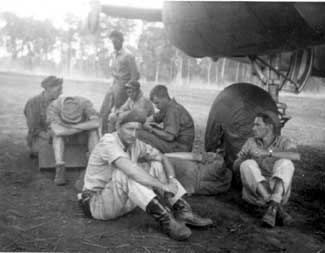 It is early morning at Durand Drome near Port Moresby and the crew of a 3rd Attack Group B-25C wait under their Mitchell for take off orders. Note the looks of concern and despair on the faces of these men. Little wonder, for the 3rd Attack suffered badly at the hands of Japanese fighters in their early New Guinea days. Their worst mission took place on 25th May 1942 when five out of the six despatched to bomb Lae failed to return. One of them is still missing in the year 2000.
The first ever B-25 Mitchell lost by the Fifth Air Force was written off in a crash landing at Seven-Mile following the first Mitchell mission in the SWPA. The mission was to Gasmata, and the aircraft lost was B-25C #41-12514. This historic event took place on 6th April 1942, led by the Commander of the 3rd Attack Group, Lt-Col 'Big-Jim' Davies.
(Source: Aerothentic) |
8th Moves Back to Charter Towers (May 1942) The 8th squadron moved back to Charters Towers, Australia on 9 May 1942. In May 1942, the air crews started intensive training in their Douglas A-24 Dauntless aircraft. During the early months, there were quite a few accidents with the 8th encountering an air-to-air incident on 5 June 1942. Jack Heyn stated, "... Just thought I would let you know (for what it's worth) that is one incident that I eyewitnessed. It was early in '42 when the 8th Sq. still had some Dive Bombers (A-24's) left. The formation had just taken off, formed up and was flying past the camp area; must have been 8 or 10 memory is a bit hazy on that. At any rate that many noisy little A-24's passing over caught our attention. They were about 1000 to 1500 feet, right over us, when the last plane in the javelon-down formation got too close to the guy in front of him. His prop chewed the tail off and both came tumbling down. We were yelling at them to bail out (as if they could hear us). Three of them got out. The pilot of one did not, and he had just got back on flying status, from a medical problem. Was his first mission back. That was a hell of a way to go -- but then, there aren't any easy ways. Since Bill had sent you the photo of one of the planes, I just thought you might like the facts behind the photo. Regards, Jack"
On June 5th, 1942 12 A-24's took off under the leadership of Captain Galusha for a practice formation flight. As the flight returned to the field in a echelon formation, Lt. Davidson's ship cut off the tail assembly of Lt. Larronde's ship. Both Larronde and his gunner bailed out safely. Sgt. Minkle hit the silk in the nick of time. Davidson stayed with the plane and was killed in the crash.
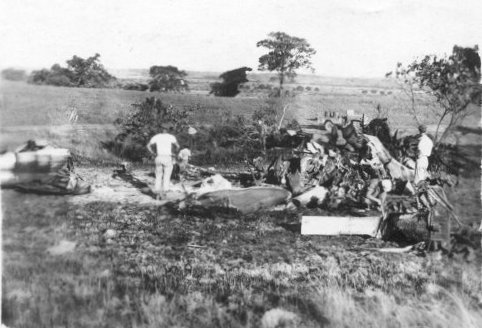
Mid-air accident with 8th BS aircraft at Charter Towers (5 Jun 1942) (Bill Swain)
According to Charter Towers: Jack Heyn:The early months of the war were very costly to the Group in both men and planes, both of which were in extremely short supply in the S.W.P.A. The A-24's were slow and sitting ducks for the Jap Zeros. The B-25's as high level bombers were also slow and altho better armed were still treated badly by swarms of Zeros. On May 25, '42 6 B025's attacked Lae and one of them came back. Many times they were flying with out escorts. On July 29, '42 seven A-24's took off from Moresby to attack a convoy approaching Gona. They were supposed to have escort fighters, but lost them over the Owen Stanley Mts. They went in on the convoy without them - one A-24 survived that mission, and that was the end of the dive bombers in the 3rd Bomb Gp. By this time the 89th Sq. had received some A-20's and the 13th and 90th were getting some replacement B-25's. The 8th would sit idle for a while until it too received A-20s.
It didn't take Pappy Gunn and the powers that be too many of those costly mission to come to the conclusion that both the A-20's and B-25's were as useless as a third tit as high level bombers. Pappy came up with the idea of turning them into low-level attack planes. Along with Jack Fox, a N.A. factory rep they started experimenting with eliminating the bombardier and putting guns in the nose. They did most of the experimenting and testing at our base in Charters Towers. They came up with several different configurations. They put two 50 cal guns in pods on each side of the fuselage. The they tried different combinations in the nose. One had four 50's, one had a 20mm canon and three 50's, and the last had a 75mm canon in the nose. This was known as Pappy's Folly or Pappy's Flying Tank.The final conversions were done in Brisbane, and then they started coming out of the factory that way. Counting the two turrets when they were swung forward, they could have 12 forward firing 50 Cal guns, and that was some fire power. The pilots started practicing the new skip-bombing technique on a derelict ship in the Moresby Harbour. Becoming very proficient at their trade. 
B-25 Mitchell Bomber
The Tide of Battle Changes (July 1942) Between 4-8 May, 1942 the Battle of the Coral Sea was fought between Allied and Japanese carrier forces. Allied bombers joined USN aircraft in attacking the enemy's main support force around the south of San Cristobal Island, Solomon Islands. The aircraft carrier Shokaku was severely damaged by aircraft from the carriers USS Lexington (CV-2) and USS Yorktown (CV-5). USS Lexington was damaged so severely that it later was sunk by USN fire. USS Yorktown also suffered damage from aircraft. Both sides lost heavily in aircraft, US losses totalling 66 and the Japanese considerably more. The Allies turned back the sea assault against Port Moresby, a key base in New Guinea and of great importance to the security of Australia. The battle is the first major naval engagement in history in which the opposing warships do not exchange a shot. The Coral Sea battle marked the end of the period in which the Allied forces in the SWPA were only on the defensive and pavee the way for offensive operations. The reconnaissance work of the AAF proved of greater importance than its bombardment operations, which have no real effects on the battle. Lack of USN-AAF coordination is apparent from the Coral Sea action, and this eventually leads to better interservice communication.
During the Battle of Midway, 4-5 June 1942, the Americans sank four Japanese carriers and the tide of war shifted to the favor of America and her allies. The 3rd Bombardment Group stepped up its attacks against the Japanese, employing new tactics and weapons as more men and aircraft arrived. The grim days of 1942 began to fade into memory.
A-24s Removed From Service (Aug 1942): After the tragic Buna Battle, the A-24s were removed from service and the rest of the 3rd BG units, including the 8th, were forced to wait impatiently for their A-20 aircraft. According to Joe Baugher's site on the A-24, "The A-24 was never very popular with its crews, and most of them were retained in the USA for training duties. After the 8th lost 5 aircraft on 29 Jul 1942, the A-24 was removed from combat. Following the New Guinea debacle, only one other squadron was to take the A-24 into combat. After the war, the Dauntless/Banshee was quickly phased out of military service." (Go to Joe Baugher's site at Joe Baugher: A-24 for more information.)
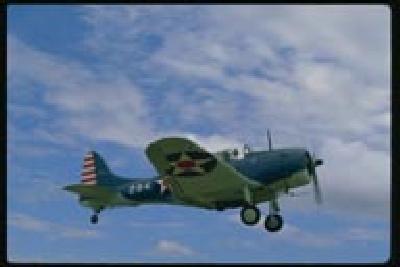 A-24B Dauntless/Banshee A-24B Dauntless/BansheeAfter the tragic losses of 29 July, the A-24s were removed from service, training at Charters Towers continued with the A-20s borrowed from the 89th. However, the squadron continued to be bypassed with the aircraft going to other units. In July the Eighth Squadron really buckled down and the three A-20s borrowed from the 89th were kept constantly fIying. The remainder of the 8th's pilots were checked off.
What followed was a low-point in the 8th's history. Throughout the remainder of 1942, the 8th remained without aircraft. Many of the leading pilots with the 8th were transferred to the 89th Squadron. From September 1942 to February 1943, while the flying officers flew with the 89th, the ground personnel acted as a service squadron. However, many times they were idle and morale bottomed out.
8th Without Aircraft (Sept 1942-February 1943) In May 1942, the Squadron settled down to enjoy the rumor that eventually it would receive A-20 airplanes equipped with four .50 cal. machine guns in the nose in addition to the four guns on the regular installation. Capt. Galusha, acting as Commander in Capt. Rogers' absence at Port Moresby, obtained three A-20s from the 89th Squadron and proceeded to check out the crews on the A-20.
The Squadron did not have any planes, but hopes were high that they would arrive soon and everyone was expecting action in the not-too distant future. Their expectations would soon turn to disillusionment as the planes did not arrive -- with a negative impact to morale. The crews flew with the 89th.
During June and July of 1942, the Squadron checked out on A-20s at Charters Towers. On 22 July, eight A-24s went back to Port Moresby for operations against the Japs landing at Buna. The following is from History, 8th Bombardment Squadron (L), 3d Bombardment Group (L) AAF, 31 May 1917 - 31 March 1944 (Compiled September 1945). 29 July ... Intelligence reports revealed that an enemy convoy of eight,
ships was 50 miles north of' Buna. Major Rogers was eager to contest their right to be there, therefore a flight of seven A-24s, took off, led by Major Rogers and consisting of Captain Schwab, Lts Casella, Hill, Wilkins, Dean and Parker and their 'respective gunners. Although the P-40escort did not come down with the dive bombers, Major Rogers felt it his duty to attack, even in the face of many Zeros. In a fierce engagement, the planes of Major Rogers, Captain Schwab and Lts. Cassels, Dan and Parker were shot down. Lt. Wilkins hit and sank a 6,000 ton vessel and others damaged a destroyer and several freighters. Lt. Hill, pursued by Zeros, landed his riddled plane at
Milne Bay with his seriously wounded gunner, Sgt. Sam. Sgt. Sam died a few days later from his wounds. His story is one of unparalleled heroism. After his right hand had been hit and disabled, he kept firing until he exhausted the ammunition of his .30 cal gun, and then pulled out his .45 pistol with his left hand and emptied it into a Jap fighter. Lt. Wilkins was the only pilot who made base safely.
Lts. Parker end Dean and their gunners were picked up by an Aussie patrol, but later all were captured by the Japs.
The 29th of July was the first of three tragic points on the Eighth' s proud story. This ended the first era of the 8th's part of World War II. In Major "Buck" Rogers, the Squadron lost an intrepid flyer and beloved leader; in Captain Schwab, the finest example of an army officer, and in the other pilots and gunners, a noble fighting team. The shock was terrific but the remainder of the Squadron sought to forget, after the A-24s had been declared unfit for use, by training hard at Charter Towers in their new A20s. In their borrowed A-20s, the unit continued to fly missions, but the unit remained without aircraft until March 1943. Despite this the 8th's crews distinguished themselves flying with the 89th Squadron. The following is from the History, 8th Bombardment Squadron (L), 3d Bombardment Group (L) AAF, 31 May 1917 - 31 March 1944 (Compiled September 1945), Combat Narratives, There followed a low period in the Eighth's history.The pilots were training in Charters Towers in A-20s. On 2 September, Lt. Chudoba led six A-20s to Port Moresby and on 8 September, six more were sent under Lt. Wilkins to the 89th Squadron. From this point on, many of the leading pilots of the 8th and most of its planes were transferred to the 89th. The few pilots left flew with the 89th against the Japs at Buna and on the Kokoda trail, when the Japs were within 30 miles of Port Moresby, from September 1942 to February 1943, while the ground personnel acted as a service squadron. The ground echelon moved up to Port Moresby under Captain John Karol, Adjutant, on 28 January 1943. About 10 pilots remaining with the 8th flew their turn in missions of the 89th to Salamaua, Lae, and over the trail from Yubo throughout February to April. On 3 March 1943, two crews of the 8th Squadron flew with the 89th in the Bismarck Sea Battle, 50 miles northeast of Cape Ward Hunt, New Guinea. Captain Chuboda sank a merchant vessel and Lt. Ruby attacked a destroyer which blew up immediately after. The Squadron had no planes of its own; most of its personnel were idle and morale hit an all time low. About 10 April, the 8th moved to Dobodura and became an advance echelon for the Group, servicing missions of the 89th and 90th Squadrons. It was the first bombardment Squadron flown over the Owen Stanley range and stationed where the Japs had been. (11) 3rd Group receives A-20s (Aug 1942) According to the Joe Baugher on the Joe Baugher: A-20A, "...the first operational unit to fly the A-20 in actual battle was the 89th Bombardment Squadron of the 3rd Bombardment Group which began operations from Port Moresby in New Guinea on August 31, 1942." Finally, the 8th was supplied with Douglas A-20 Havoc aircraft shortly after the 89th. They returned to Australia for a short time to train in this new type of aircraft. On September 28, 1942, the Squadron was redesignated as the 8th Bombardment Squadron (Dive).
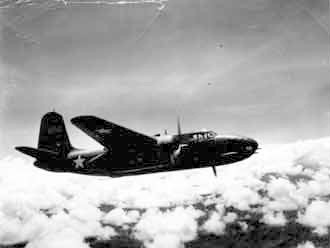

3rd Attack Group A-20As (89th Attack Squadron)According to the 3rd Wing History: "The Grim Reapers employed the low-level concept of heavy fire power and parafrags for the first time on 12 September 1942, when the 8th and 89th Bombardment Squadron A-20s, led by Capt. Donald Hall, attacked the Japanese airfield at Buna. The Japanese, expecting an attack from 3,000 to 4,000 feet were caught off guard. The A-20 crews came in at tree top level. When the last 89th Bombardment Squadron A-20 pulled away, it left the airfield a flaming wreck with 17 Japanese aircraft destroyed. On 16 December, Captain Edward Larner, led six B-25 from the 90th Bombardment Squadron on a similar low-level mission against the Japanese airfield at Salamaua. Again, the use of heavy firepower and parafrags worked, this time with the B-25.
The Grim Reapers conducted low-level attacks against ground targets in support of the Papuan Campaign, fought from 23 July 1942 to 23 January 1943, to clear the Japanese from its lodgments at Buna and Gona on the northeast coast of New Guinea. The campaign earned them their first Distinguished Unit Citation." Colonel Davies turned over command of the 3rd Bombardment Group to Lt Col Robert F. Strickland on 26 October 1942. Colonel Strickland had experienced a series of rapid promotions since his arrival early in the year. Remember that Lieutenant Robert F. Strickland assumed command on 19 January 1942, as the senior officer when the unit deployed to Australia.
8th Receives First B-25s (May 1943) On 20 May, the squadron received
two B-25s. Many new crews were assigned and checked out. Then followed 5 months of intense operations with B-25s, under the First Air Task Force, commanded by General Frederic Smith, that brought new
glory to the 8th Squadron. Finally after months of having no aircraft, the Eighth was in action again and morale picked up. Major James A. Downs assumed command in April 1943. Captain Wilkins came back from the 89th to be Operations Officer. As its combat victories mounted, the morale was soared again.
The Eighth flew the B-25s primarily against harbors and barge hunting, but also for weather reconnaissance or anti-submarine searches. Any mission without top cover faced the possibility of being jumped by Japanese fighters. Periodically a plum came their way in the form of destroyer or merchant ship -- but not often. Also they also flew as part of coordinated attacks involving other squadrons on larger airdromes. The typical method of battlefield damage assessment at the time was observing for smoke as evidence of damage. Combat photographers flew on the more important missions. Many times bad weather interfered with the missions and forced the aircraft to turn back. The following is from History, 8th Bombardment Squadron (L), 3d Bombardment Group (L) AAF, 31 May 1917 - 31 March 1944 (Compiled September 1945), Combat Narrative:
25 May - 143 AA (12) ...One B-25 searched Oro Bay for enemy submarine reported in vicinity.
A red light was sighted which was extinguished on approach. No enemy aircraft were sighted. Sighted two small lugges anchored off Buna. Search was given up due to inclement weather.
16 June -- 166 AA ... One B-25 took off on a photographic mission of the entire coastline of Kiriwina Island.
2l June -- 170 AA ... Three B-25s made a night reconnaissance for barges along coast of Huen peninsula, Rooke Island and west and north coast of New Britain. One plane encountered four heavily loaded 60 foot barges one mile west of Lagunen Point. Three barges were heavily strafed and one left low in water in a sinking condition. One plane was holed by machine gun fire. One plane was missing with crew of four. 2000 pounds of bombs were dropped and 1500 rounds of ammunition were expended. (13)
21 June - 177--BB ... Two B-25s conducted an armed reconnaissance for missing B-25 in Huen Gulf and along coast of New Guinea.
29 June - 179-FF ... Two B-25s made an air support strike to bomb and strafe enemy ambush positions near south bank of Eitei River overflow. 1200 pounds of bombs were dropped and 4100 rounds of ammunition were expended.
7 July -- 187 AA ... Three B-25s made a search mission for barges from Labu Lagoon to Cape Cretin. The barge hideout in Labu Lagoon was bombed and strafed. Mangge, Dangehohe, Bua and Hopoi villages were heavily strafed. 4 to 5 wood and tin roofed buildings were hit and a water tower destroyed. 3900 pounds of bombs dropped and 3100 rounds of ammunition expended.
7 July -- 177 CC ... A weather reconnaissance mission was undertaken by one B-25 to Dualai, Salamaua, Lae and Nadzab.
7 July -- 188 BB ... A weather reconnaissance mission was made by one B-25 to Dualai, Salamaua, Lae and Nadzab. A coconut grove at Malahang was strafed with unobserved results. 100 rounds of ammunition expended.
8 July ... A weather reconnaissance mission was made by one B-25 to Mubo, Bobdubi, Salebob, and Salamaua.
9 July 189 AA ... A weather reconnaissance mission by one B-25 was made in the area of Yubo and Bobdubi. The aircraft was not heard from after takeoff.
9 July 189-CC ... Three B-25s conducted a search mission for a missing B-25 along the coast and over the area around Mubo and Bobdubi island to Markham Valley. The missing aircraft was not sighted.
10 July -- 189 AA ... The missing B-25 (above paragraph) was intercepted and shot down by four enemy single seater fighters and one dive bomber just north of Nassua Bay. The pilot ditched the plane which sank in deep water. The turret gunner disappeared from unknown cause.
11 July -- 191 DD ... S:i.x B-25s .took off on a strafing mission of barges near Salamaua off Logui #2 and Kela Point. Airdrome installations at Logui, Kela village, and Kala Point were thoroughly strafed with a radio tower and a shack left burning. One 30 foot boat off Kela Point was also strafed. Anti-aircraft fire holed three planes. 7355 rounds of ammunition were expended.
17 July - 197-BB ... One B-25 made a weather reconnaissance mission to St. Georges Channel. Five strafing passes were made on a Sugar Charlie southeast of Cape Orford. One gun position was put out of action and light smoke was seen from the aft end of ship. Anti-aircraft fire holed the plane. 1200 rounds of ammunition were expended.
20 July -- 200 General ... Six B-25s went on a bombing and strafing mission of a partially completed bridge and two camp areas at the mouth of the Gogol River. The base of the bridge was believed knocked out by bomb hits but other results were unobserved. 12000 pounds of bombs were dropped and 10375 rounds of ammunition were expended.
22 July -- 202 General ... Six B-25s went on a bombing and strafing mission of two tracks north of Komiatum and reported anti-aircraft gun position. 11700 pounds of bombs were dropped and 6800 rounds of ammunition were expended on the targets. All bombs fell in the general target area. Malolo village was heavily strafed. One of the B-25s was slightly damaged by explosion of bombs dropped by the lead bombing B-25s.
23 July -- 203-CC ... Four B-25s made a bombing and strafing mission on buildings and the general areas around Malolo. 9600 pounds of bombs were dropped, 3050 rounds of ammunition and nine 75 mm. shells were expended. A large building, believed to be the mission building, was hit by a bomb and practically demolished. Tracers were seen to enter several European-type buildings. Results were otherwise unobserved. This is the first mission where the 75 mm. cannon mounted on a plane was used.
24 July -- 204 AA ... Two B-25s flew a Radar Tracking mission to Kiriwina Islands.
28 July -- 208 BB ... One B-25 made a weather reconnaissance in the Lae-Salamaua dropping area..
29 July -- 209 OO ... Six B-25s made a bombing and strafing attack against a large damaged two stacked destroyer off Cape Glouster Airdrome. The destroyer was practically destroyed by direct hits left in a burning condition with a violent explosion occuring about 20 minutes after the attack was terminated. The pilot and observer were injured by shrapnel coming through the canopy of one of the B-25s. All anti-aircraft positions of the destroyer were silenced by the attack. 13000 pounds of bombs were dropped and 5400 rounds of ammunition was expended in strafing.
30 July -- 210 GB ... A weather reconnaissance by one B-25 was made off Finischhafen.
31 July -- 211 AA ... Nine B-25s made a bombing and strafing strike on barge hideouts at Langemak Bay, Hanisch Harbor, Finschhafen, Sio and Uarien Harbor. One modern building was destroyed by bombing on the west side of Hanisch Harbor. Three beached barges were bombed and strafed near Mange Pt. One barge was bombed and strafed near Arndt Pt. The mission, wharf and plantation areas at Finschhafen Harbor were thoroughly strafed and bombed. 5400 pounds of bombs were dropped and 4800 rounds of ammunition were expended.
1 August 212-AA ... A.weather reconnaissance in the Finschhafen and Huen Gulf areas and photograph mission of Mape River and Langemak Bay was made by one B-25.
3 August. - 214 AA ... A bombing and strafing mission was made by eight B-25s on barges in Mape River and south of Masaweng River. Seven to nine camouflaged barges and one cabin launch were bombed. and strafed along the south bank of Mape River. A motor launch was left burning and several barges were destroyed. On barge was hit and left burning just south of Masaweng River. 14400 pounds of bombs were dropped and 10050 rounds of ammunition were expended in strafing.
6 August 217-AA ... A weather reconnaissance was made by one B-25 to Salamaua and Lae areas and Arawe.
7 August. 218-AA ... An armed weather reconnaissance mission was made by one B-25 to Langemak Bay, Itni River and Arawe area. A type E barge was sighted near the second bend of Nape River and strafed twice with tracers seen entering it. One Jap was seen lying on barge and is believed to have been killed. 450 rounds of ammunition were expended.
7 August. - 218-BB ... Nine B-25s made a bombing and strafing mission on barges near
Lagunen Point. Two type B barges bombed and strafed just north of Lagunen Point, but the attack was broken off and results unobserved due to interception by two or possibly three enemy single seat fighters. One radial-engine single seat fighter was shot down smoking into the water, where it was seen to cartwheel. 600 pounds of bombs were dropped and 2276 rounds of ammunition were expended in strafing and firing on enemy fighters.
12 August -- 213-BB ... 12 B-25s made a barge search mission to Langemak Bay, Rooke Island, Bergen, Rotteck and Rein Bays. All aircraft, turned back at Morobe without completing the mission when the fighter escort gave the signal for return to base because of bad weather.
17 August -- 228 General ...12 B-25s participated in a strike on aircraft on Boram and Weviak Airdromes. The airdromes and surrounding areas were heavily strafed and bombed with good results on parked enemy aircraft. 7452 pounds of bombs were dropped and 1330 rounds of ammunition were expended in strafing.
18 August -- 229 General ... 12 B-25s took off for a mission against supply dumps at Boram and Wewak Airdromes. 9600 pounds of bombs were dropped and 6200 rounds of ammunition were expended in strafing. One B-25 was shot down by an intercepting enemy single seat fighter. Several enemy aircraft were seen shot down by other squadrons and escorting fighters. Bombing and strafing were considered good.
20 August -- 231_BB ... Seven B-25s took off on a barge search near the Cape Busching area. Four barges were strafed with unobserved results. 700 rounds of ammunition were expended in strafing.
23 August -- 234_BB ... A barge search from Saida to Langemak Bay was made with six B-25s. A rowboat, wharf and houses were bombed and strafed. 400 pounds of bombs were dropped and 70 rounds of ammunition were expended.
25 August -- 236 General ... A shipping sweep of Hansa Bay and surrounding harbors was participated in by nine of our B-25s. Many luggers, barges and Sugar Charlies were heavily bombed and strafed with good results. Two B-25s were damaged by anti-aircraft fire. 29500 pounds of bombs were dropped and 10100 rounds of ammunition were expended.
28 August -- 239 AA ... Nine B-25s took part in a shipping sweep of Hansa Bay and surrounding area. Shipping barges were heavily bombed and strafed as were nearby supply installations on shore. Good results were observed although one plane was lost when its left wing was blown off by an explosion aboard one of the damaged luggers. 13500 pounds of bombs were dropped and 7250 rounds of ammunition expended.
30 August -- 247 BB ... One B-25 made a reconnaissance of the Lae - Salamaua dropping area.
1 September -- 243-BB ... 12 B-25s participated in a barge hunt around the Bergen Bay area. Several barges were bombed and strafed as were the surrounding villages. Good results were observed. 5300 pounds of bombs were dropped and 6300 rounds of ammunition were expended.
3 September -- 245 AA ... Nine B-25s participated in a strike against enemy aircraft, antiaircraft positions, and store and personnel areas at Cape Gloucester. Results were good although one B-25 was holed. 14904 pounds of bombs were dropped and 12300 rounds of ammunition were expended.
4 September -- 246 AA ... A bombing and strafing attack against the Cape Gloucester Airdrome was made by nine of our B-25s. Four of our planes were holed. The airdrome was thoroughly covered by bombs and strafing. 14076 pounds of bombs were dropped and 6450 rounds of ammunition were expended in strafing.
4 September -- 246 CC ... One B-25 made an armed reconnaissance of the Nadzab area.
7 September -- 249-BB ... Ten B-25s participated in a bombing and strafing mission east of Nadzab on Markham Road. 11040 pounds of bombs were dropped and 8050 rounds of ammunition were expended.
10 September -- 252_DD ... One B-25 took off on a weather reconnaissance mission to Wau, Tsili Tsili and Markham Valley.
12 September -- 254_AA ... One B-25 took off on a. weather reconnaissance mission of Morobe, Salamaua and surrounding areas.
16 September -- 258 AA ...Eight B-25s participated in a bombing and strafing strike against Lae Defense Area No.6. Results were unobserved though 8694 pounds of bombs were dropped and 13800 rounds of ammunition were expended in strafing.
17 September -- 259 AA ... One B-25 made a weather reconnaissance mission over Nadzab and Lae areas.
18 September -- 260 DD ... Nine B-25s attempted a bombing and strafing mission against barges and luggers at Krongrins Harbor but were turned back due to bad weather.
19 September -- 261 EE ... A barge search mission was made by six B-25s from Sio to Finischhafen and and surrounding areas. Several barges and the village areas were thoroughly bombed and strafed with good results. l3200 pounds of bombs were dropped and 10200 rounds of ammunition were expended.
22 September -- 264_EE ... Simban Village and the track area from Timbulum Point to Godowi Point were thoroughly bombed and strafed by nine B-25s with 18300 pounds of bombs and 13450 rounds of ammunition.
24 September -- 267 EB ... Two B-25s dropped ammunition to friendly forces south of Pong River and conducted a weather reconnaissance of the Finschhafen area.
27 September -- 260 General ... Nine B-25s participated in a shipping sweep of Victoria Bay and near Kairuru Point. A Fox Tare Charlie, two luggers, a Sugar Charlie and a 40 foot cabin launch were definitely destroyed besides damaging various other small craft. Villages in the Kairuru Point area were thoroughly bombed and strafed. One B-25 was lost due to anti-aircraft fire and five other planes were holed. 13500 pounds of bombs were dropped and 7150 rounds of ammunition were expended.
30 September -- 272 AA ... One B-25 made a weather reconnaissance over the Lae-Nadzab and Dunrpu areas.
30 September -- 272 BB ... One B-25 dropped supplied to friendly forces near the Finschhaven area.
1 October -- 273-CC ... Nine B-25s made a shipping sweep from Bungula Bay to Commodore Bay but were turned back with the mission only 50% completed due to insufficient fuel. One power boat was strafed with 400 rounds of ammunition.
2 October -- 274-CC ... One B-25 made a photo reconnaissance mission of the New Britain coast from Grass Point to Ammen Point and surrounding areas at low altitude. 500 rounds of ammunition were expended in strafing a barge.
3 October -- 275 AA ... Nine B-25s took off for a barge hunt along the coast of New Britain from Itni River to Higgens Point. One barge was destroyed and several damaged by 2700 pounds of bombs and 1650 rounds of ammunition.
4 October -- 276 CC ... Six B-25s attempted a barge and shipping sweep around Garove Island but were forced to return due to bad weather. When the weather cleared, six B-25s took off to complete the mission. Several barges and one motor launch were bombed and strafed with the motor launch definitely destroyed. Kuriga village and surrounding areas were also thoroughly bombed and strafed. One plane received a hit from machine gun fire. 13800 pounds of bombs were dropped
and 8450 rounds of ammunition were expended.
12 October -- 284 AA ... 15 B-25s participated in a bombing and strafing mission against Rapopo Airdrome and supply and personnel areas. Approximately 28 enemy aircraft were destroyed or damaged on the ground plus large damage to supply dumps and personnel areas. Two barges were also heavily strafed. 17112 pounds of bombs were dropped and 23550 rounds
of ammunition were expended.
13 October -- 285 AA ... 12 B-25s attempted a shipping sweep in Keravia Bay but were turned back due to bad weather.
l6 October -- 288 CC ... 12 B-25s attempted to intercept enemy naval and merchant shipping north of Long Island but were unable to contact them due to bad weather and the low altitude course of the planes.
21 October -- 293 AA ... Nine B-25s took off to bomb and strafe Wareo Village and mission and the track west from Masankoo village. 10200 pounds of bombs were dropped and 14300 rounds of ammunition were expended in strafing.
24 October -- 296 AA ... Rapopo Airdrome dispersal areas was the target for nine B-25s. Despite interception by approximately 25 enemy single seat fighters, 8100 pounds of bombs were dropped - and 8700 rounds of ammunition were expended on the target area. 1400 rounds of .30 calibre ammunition were expended against the enemy fighters. One B-25 was shot down and two damaged against the score of six enemy single seat fighters definitely shot down, two probably destroyed and one damaged. One pilot was slightly injured and one gunner was shot through the leg.
24 October - 296 BB ... Three B-25s took off on a search for Jap destroyers near Rein Bay. No destroyers were sighted.
26 October -- 2QS-AA ... Nine B-25s attempted a shipping search in Simpson Harbor but
were turned back due to bad weather.
2 November-- 305 AA (14) ... Ten B-25s made a shipping sweep of Simpson Harbor with the following results: Four Fox Tare Ables -- one large freighter, one large destroyer, on Fox Tare Charlie, one Sugar two stacks and one CA were badly damaged. The town area. was also thoroughly strafed. Two B-25s were shot down and two B-25s were damaged by anti-aircraft fire. One gunner was killed and two wounded. 10000 pounds of bombs were dropped and 10000 rounds of ammunition expended. (SITE NOTE: See MOH and Major Raymond Wilkins for details on the Medal of Honor citation and the man.) 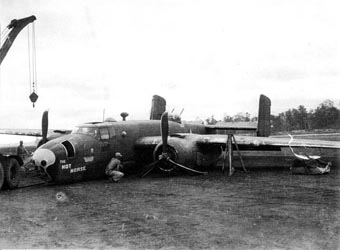 B25D-10-NA The Hot Horse # 41-30274:
The Hot Horse crash-landed at Dobodura after the infamous bloody Rabaul raid of 2nd November 1943. The aircraft was nearly junked after this, but instead they sent it to a service squadron where it was rebuilt and transferred to the 345th Bombardment Group. In the photo you can see a derrick and under-the-wing jacks being brought in to move the ship.
Some of the other Mitchells lost on this infamous raid include Notre Dame de Victoire, which ditched off the island of Kiriwina, Fiji, Hellzapoppin, Tugboat Annie, and The Nip Clipper. (Source: Aerothentic) |
 Tug Boat Annie, lost on 2 Nov 43 (Courtesy Bill Swain) Tug Boat Annie, lost on 2 Nov 43 (Courtesy Bill Swain)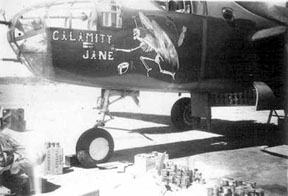 B-25D "Calamity Jane" Serial Number 41-12962:
Calamity Jane carried rather macabre nose-art, and was named by her aircraft commander Robert A. Price after his wife Jane. She joined the war with the 13th Bombardment Squadron and carried out many missions over New Guinea before being converted to a strafer after which she was re-assigned to the 90th BS, and 3rd Group Commander 'Jock' John Henebry, who renamed her M & M. On 27th July 1943 she hit a barge and crashed into the West side of Hanish harbour with Captain Oscar L. Wertz at the controls.
In this photo Calamity Jane is seen at Schwimmer Drome, Port Moresby, just after having flown up from Australia with canned foodstuffs. (Source: Aerothentic) |
NOTE: There was an entry on Aerothentic about the Kila Drome at Port Moresby that provides some insight into the valor of the aircrews bringing their crippled aircraft home. Note that this B-25C aircraft is NOT an 8th aircrew as it is not mentioned in the unit history. It stated, "Several units used Kila Drome in the early days, including P-40Es of the 49th FG, A-20As and B-25s of the 3rd Attack, and P-39s of the 8th FG. All shared this common ambulance however, seen parked against the operations hut at the Drome, complete with its camouflaged roof."
Sunday 1st November 1942 was a day when the ambulance would be needed, when a returning B-25C named Iraquois circled Kila Drome cutting its engines to signal a crash-landing. Ground crews ran up to the crest of the nearby hill to watch it put down.
From the diary of Adrian Bottge, a 3rd Attack crew-chief, who witnessed proceedings, and wrote in his diary that nite,
"he came into the runway with the wind. His nose-wheel hung loose but he was doing fine until he hit a pile of sand at the edge of the strip. He nosed over, doubled the nose under the fuselage - one engine burst into flame as he came to a stop. Not a pretty sight. Turned out that the pilot had been killed over the target and the gunner badly shot up. The co-pilot brought the ship in with hung bombs still in the bomb-bay. Only the bombardier survived the bullets, crash and fire". This drew to a close the B-25 era of the 8th Squadron and started the A-20 era. On 19 Nov 1943, nine A-2s bombed and strafed camp, supply and barge staging ,areas from Gunke to Sialua Island.
Move back to Port Moresby (Jan 1943) In January 1943, the Eighth Squadron still only had two serviceable aircraft -- A-20s borrowed from the 89th -- and 280 very discontented men. The middle of January found the squadron packed and ready to move on one day's notice. On January 17th and 18th all equipment was loaded on the railcars and departed with guards to Townsville. On January 23rd an advance party was sent to Port Moresby to select a camp site and start preliminary construction in required. The most accute problem was the shortage of water which was resolved by Captain Downs and T/Sgt Royle.
The main body of the Eighth arrived on January 28th after a "depressing" three-day boat ride. On 28 January 1943, the ground echelon moved up to Port Moresby under Captain John Karol, Adjutant. The 10 pilots remaining with the 8th flew their turn in missions with the 89th. The Squadron had no planes of its own, most of its personnel were idle, and morale hit an all-time low. The crews continued flying missions with the 89th.
This would be only one of the many moves the Group would conduct in the months ahead, as the Americans and Australians slowly drove the Japanese from New Guinea and Solomon Islands. These included Nadzab, New Guinea (February 1, 1944); and Hollandia, New Guinea (May 6, 1944). Until the New Guinea Campaign was over.
After the A-24s were removed from combat, the pilots of the 8th flew with the 89th Squadron (of the 3d Bombardment Wing) on missions including the famous Bismarck Sea Battle on March 3-4, 1943. Because they were being pushed back in New Guinea, the Japanese attempted to reinforce their other garrisons on the island. On 8 February 1943, reports reached the 5th AF that the Japanese were assembling a convoy at Rabaul, its stronghold in the Solomon Islands. The Japanese planned to send reinforcements to Lae.
According to the 3rd Wing History, On 1 March 1943, the crew of a B-25 from the 90th Bombardment Group spotted the Japanese convoy as it headed south southwest through the Bismarck Sea, carrying an infantry division along with engineers troops and tons of equipment and supplies. It set the stage for the Battle of the Bismarck Sea, one of the decisive air operations of the war.
The next day, B-17 crews dropped bombs on the convoy, claiming two ships. A Royal Australian PBY Catalina followed the convoy during the night of 2-3 March. Australian Beaufort attack bombers made an unsuccessful torpedo attack during the early morning hours of 3 March. More attacks by American and Austrian aircraft followed without success other than scattering the convoy. The Grim Reapers went in next with the 89th Bombardment Squadron’s A-20s and the 90th Bombardment Squadron’s B-25s.
(SITE NOTE: 80th pilots and crews flew with the 89th Bombardment Squadron during the Battle of Bismark Sea. On 3 March 1943,: two crews of the 8th Squadron flew with the 89th in the Bismarck Sea Battle, 50 miles northeast of Cape Ward Hunt, New Guinea. Captain Childoba sank a merchant vessel and Lt. Ruby attacked a destroyer which blew up immediately after.)
Both squadrons had practiced low-level attacks against shipping in which they would come in at deck level, machine guns blazing, and then skip bomb their bombs into the side of their targets. The tactics worked. When the two squadrons departed the scene at 10:30 AM, they counted 27 direct hits. The aircrews returned to their advance base at Dobodura on the northern coast of New Guinea to rearm. That afternoon, they struck again. By the end of the day, The Grim Reapers had sunk or damaged 13 of the 18 ships claimed by the Fifth Air Force. The Japanese lost 6,000 men. Only a crippled destroyer and a transport reached Lae, both of which were sunk later. The battle proved that air power could destroy a fleet at sea. Accolades and awards poured in. General George Kenney, Commander, Fifth Air Force, wrote his congratulations to The Grim Reapers, stating: "Congratulations on the stupendous success. Air power has written some important history in the last three days. Tell the whole gang that I am so proud of them I am about to blow a fuse.”
The Grim Reapers lost four aircraft with 13 men killed and another 12 wounded. Their sacrifice, however, took the initiative away from the Japanese and sealed the fate of the remaining Japanese garrisons on New Guinea. The 3rd Bombardment Group, from its base at Dobodura, where it had moved in May 1943, continued to hammer away at the remaining Japanese garrisons. Major Donald Hall replaced Colonel Strickland as commander on 28 April 1943. During this engagement 5th Air Force units sank an entire 20 ship convoy carrying reinforcements which the Japanese needed badly to hold their positions at Buna. (NOTE: Other sources say there were 12 ships sunk.)
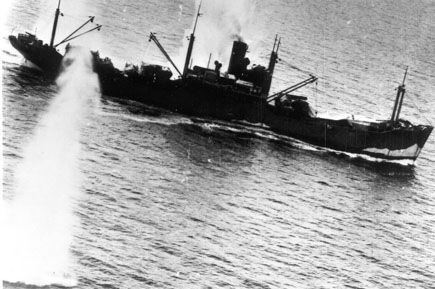
Battle of Bismark Sea (USAAC)
For inputs or comments, contact Kalani O'Sullivan.NOTICE/DISCLAIMER: The content of this page is unofficial and the views and opinions expressed do not necessarily reflect those of anyone associated with this page or any of those linked from this site. All opinions are those of the writer and are intended for entertainment purposes only. Links to other web pages are provided for convenience and do not, in any way, constitute an endorsement of the linked pages or any commercial or private issues or products presented there.
 You are listening to Begin the Beguine You are listening to Begin the Beguine
Return to Top | 
28 October 2003 |
For inputs or comments, contact Kalani O'Sullivan.NOTICE/DISCLAIMER: The content of this page is unofficial and the views and opinions expressed do not necessarily reflect those of anyone associated with this page or any of those linked from this site. All opinions are those of the writer and are intended for entertainment purposes only. Links to other web pages are provided for convenience and do not, in any way, constitute an endorsement of the linked pages or any commercial or private issues or products presented there.
Copyright 2003 - All Rights Reserved
email to: kalani@hanvit.com

FastCounter by bCentral
|

